Archive for the ‘Wildness’ Category
Tuesday, October 25th, 2011
This article was initially published by Tigerquoll onCanDoBetter.net on 20090524:
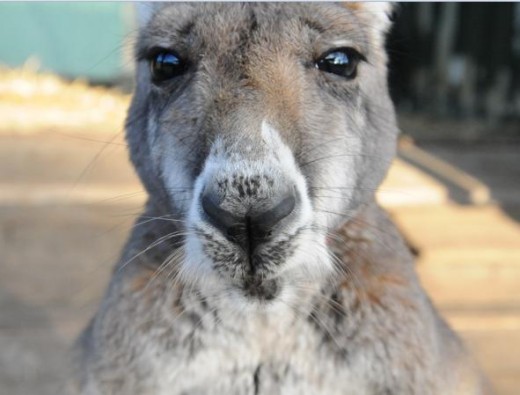 Australia’s native kangaroo – targeted by poachers and mass slaughter encouraged by Australian governments
Australia’s native kangaroo – targeted by poachers and mass slaughter encouraged by Australian governments
.
The Australian outback town of Mitchell lies in the Western Downs region of southern Queensland on the Warrego Highway just shy of 600 km west of Brisbane on the way to Charleville. Situated on the Maranoa River, the town of Mitchell was named in honour of the 19th Century explorer, and the town emerged as a pastoral town out of the farming of grains, beef and sheep. Tourism has become a strong drawcard to Mitchell and especially to its Great Artesian Spa.
But more recently, Mitchell’s fame has been lowered to infamy with it taking on a reputation for becoming the home of the kangaroo slaughter trade.
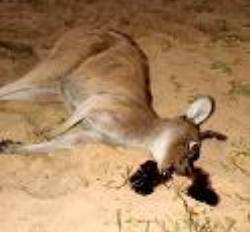 . .
“You see a lot of utes in Mitchell and the towns just like it that emerge from the roadside only to disappear again as you drive west through southern Queensland on the Warrego Highway. You can tell the ones that are driven by kangaroo shooters. They have racks for guns and long spikes upon which the freshly eviscerated carcasses are placed. One, parked just around the corner, has black steel bullbars with the words “roo raper” cut into them.”
.
‘Besides the slaughter of Australia’s iconic kangaroos for pet meat and indeed export for human consumption in fancy restaurant,
it is the sanitary conditions that is shocking and a life threatening time bomb’
.
Following the international biolab standards of Silliker, animal liberation chief, Mark Pearson says “the last time we did swabs here and in Charleville, they were alarmingly high in E.coli.“
‘The chiller doors aren’t locked. When Ben-Ami opens the first, problems are immediately apparent. Bright drips from fresh kills are spotting onto another layer of older, duller, deader blood, which is particularly thick nearest the front. The lip of the door frame is so thick and sticky, the red’s turned a dull, dark brown. Hairs are stuck to it.
.
‘The carcasses are packed as tightly as possible.
They hang from hooks by their legs,
their heads and tails missing,
gaping rents where their stomachs once were,
leg muscles tensed visibly;
severed necks poke into gut cavities;
hundreds of paws hang in a grisly reach towards the bloody floor.
According to their tags,
they’re four days dead.’
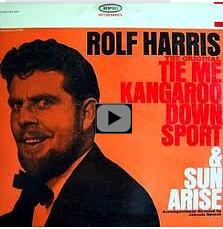
“These are quite young ones, heads cut off quite low,” Pearson says, pointing to a nub of spine that’s jutting out just above the shoulder.
“Most of them are cut too far back.” To decapitate in this way requires significantly more effort than using the traditional method, with a slice directly beloiw the jawline. It also makes bad financial sense to remove most of the neck , as harvesters are paid by weight. Proof, claim the activists, that an illegal shot in the jaw or neck has been covered up.
‘Pearson points to the floor. “They’re bringing in new carcasses and hanging them above the floor, which has blood from old carcasses. Blood is a Petri dish for disease and contamination. This is a major breach of any export abattoir standards.” he points to a small grey kangaroo that is caked elbow to paw in blood and dirt. “That’s from the evisceration,” he says. That’s all supposed to fall to the ground. And don’t forget, these would have been on the back [of a ute] for four, five, six hours, and it would have been 20 degrees. When you consider this is export meat…Uh-oh…”
Besides Mitchell, the roo rapers store their roo chillers at Charleville, Augathella and Blackall. The practice in outback Queensland is widespread.
To struggling towns in the outback like Mitchell, kangaroo meat is big business. “The Kangaroo Industry Industry Association of Australia says theirs is a business worth $270 million a year that directly employs about 4000 people” many in remote areas.”
[Source: Sydney Morning Herald, Good Weekend magazine, 20090523]
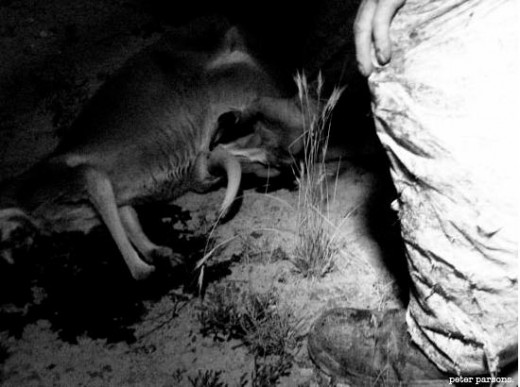
.
AusHunt, a website dedicated to hunting in Australia and it’s hunters, advocates:
.
“Kangaroo shooting is a unique job and many people are involved in one way or another in Australia’s kangaroo industry. My advice for the wannabe ‘roo shooter? You’ll need to make a few phone calls to chiller-box operators in various rural centers to evaluate the impact another ‘roo shooter would have there. Then decide on a location.
Before doing anything, take a week off work and go out with a qualified, professional ‘roo shooter and see what is actually involved.
Australia’s kangaroo industry is one of the only jobs in the world where a person can legally shoot wild animals full-time for a living.
Kangaroo shooting is a tough life with long hours, and a certain danger element. Depending on weather conditions (wind, rain), phases of the moon and drought, the kangaroo shooter may have a good or bad night. It can be a very irregular income earner.
Many shooters struggle to make money, some make a living, and a few make good profits of A$100,000/annum +. Dedication is the name of the game …. going out night after night and avoiding the temptations of the local pub. The upside is that the shooter is very independent and can lead an exciting outdoors life, totally using his wits, determination and shooting prowess to make money.
Okay, you like what you see and you’ve done your courses. Move to the rural center that you have selected and get a day job there, whether it be pumping gas or whatever. Then, start looking around for properties on which to shoot and start off by shooting week-ends. See how you go, then move on to fulltime when you know that you can make money. Good luck!”
.
.
‘Kangaroo harvesting under the spotlight’
.
Animal welfare activists are hoping public outrage over the slaughter of cattle in Indonesia can be redirected towards a new target – the commercial harvest of kangaroos. But activists’ involvement with research at the University of Technology, Sydney (UTS), has sparked a major scientific blue.
A year ago, animal welfare group Voiceless established THINKK at UTS, specifically to oppose the commercial kangaroo harvest. The unit’s lead scientist, ecologist Dr Dror Ben-Ami, says a lot of information about the kangaroo industry is misrepresented and not researched thoroughly.
This year, the national quota for the commercial harvest of kangaroos is set at around 3.7 million animals, but Dr Ben-Ami fears the real toll may be much higher.
“We estimate that up to a million dependent young are killed inhumanely every year as a result of the kangaroo industry,” he said.
“Those numbers come from industry statistics, in the sense of how many females are killed every year, and from behavioural reproductive ecology knowledge about how many young each female will have.”
There are in fact no industry figures on how many joeys are killed. Their main protection is the commercial shooters licence, which bans the hunting of females with dependent young.
Professor Mike Archer, the dean of science at the University of New South Wales (UNSW), says shooters are aware female kangaroos may be carrying joeys.
“There is an effort made by the shooters. They’re aware of this issue,” he said. He has raised questions about the research being done by THINKK.
“If a group like that were actually based in my university, in the University of New South Wales, we would be having a very serious think about whether they actually belong there,” he said.
“If they publish their own papers, refereed their papers themselves, didn’t quote real experts in the field, we would be very uncomfortable if they were operating in UNSW.”
.
Hygiene fears
.
Adult kangaroos are shot by night and driven to chillers the next day for processing, leading to another of THINKK’s major concerns – the hygiene of the meat.
In early 2009, Animal Liberation collected samples from unlocked outback chillers, which tested positive for E. coli and salmonella. Several months later, major export destination Russia slapped a ban on kangaroo meat, citing contamination fears.
“If one ate kangaroo meat with high levels of E. coli, you’d have a upset stomach – that would be the case with most people,” Dr Ben-Ami said.
Animal Liberation went on to set up new lab tests of supermarket meat. Dr Ben-Ami says the findings are concerning.
“The results have shown very high levels of E. coli, above alert levels of 1,000 colony-forming units and also a couple of samples came back positive for salmonella,” he said.
There are hundreds of different kinds of E. coli, but only some can be toxic. Animal Liberation’s tests did not establish whether the E. coli found in the kangaroo meat was dangerous.
But UNSW researcher Rosie Cooney says Dr Ben-Ami’s concerns about the contamination of kangaroo meat are overstated.
“A large study done some years ago that looked at over 200,000 carcasses found in fact that the rates of rejection for contamination of kangaroo carcasses were actually considerably less than those for sheep,” she said.
Science ‘under siege’
Dr Cooney and her colleagues believe when it comes to the commercial harvest of kangaroos, the science is now under siege. This has spurred them into action, with a national group of scientists about to publish a critique of THINKK’s claims.
This group says the research proves there is great environmental benefit in encouraging farmers to harvest kangaroos for profit.
“They’re then going to want to value those animals, keep them on their land and importantly, maintain the habitat, the native vegetation, for those creatures as well,” she said.
Dr Ben-Ami says his critics should “write back and engage in academic dialogue, rather than smearing”.
THINKK has today released a new paper arguing against the kangaroo harvest on animal welfare grounds. Their key claim is that that shooters are missing the mark and joeys are being left to die.
[ Read Paper]
“We’re taking a native animal out of its natural habitat in great numbers every year and thinking that that has no ramifications, and I think that’s absurd,” he said.
With both sides claiming the science is on their side, the challenge for animal welfare groups is to get kangaroos off the menu.
..
[Source: ‘Welfare Activists Target Kangaroo Industry‘, by Sarah Dingle and staff, 20110713, ABC Western Queensland, ^http://www.abc.net.au/news/2011-07-13/welfare-activists-target-kangaroo-industry/2793878/?site=westqld, accessed 20111025]
.
.
Would you eat this animal?
.
Natural resources are at the heart of the booming Australian economy. In particular, the country’s success in selling these economic growth goodies to a ravenous China has transformed the Aussie economy.
China is today Australia’s largest trading partner, buying up iron ore, coal, natural gas, and other industrial minerals to the tune of $55.2 billion a year — or more than 20 percent of Australia’s total exports. So it’s not too surprising that some entrepreneurial Australians want to add another natural resource to that growing list: kangaroo meat. Australia is crawling with the creatures. And China is apparently hungry for them.That’s the plan, anyway, according to this fine feature story from Matt Siegel in the New York Times.“The Chinese have a strong culinary tradition in using wild foods, not just meat, but a wide range of wild foods called yaemei in Cantonese and yewei in Mandarin,” John Kelly, executive director of the Kangaroo Industry Association of Australia, a lobbying group, told Siegel. “Kangaroo will to a large extent just slot right into that existing tradition in much the same way it has in the European markets.”
China sent a government delegation to Australia last December to investigate the health and sanitary conditions of kangaroo producers, the New York Times reports.
And not without reason. Kangaroo meat has come under increasing scrutiny following an E. coli outbreak in 2009, which led to a ban from kangaroo-scarfing Russia. The health scare also triggered a collapse of kangaroo meat exports, which tumbled from $38.4 million in 2008 to just $12.3 million last year.
But the new plan to sell kanga-meat to China comes with other challenges. First off, kanga meat is a hard sell — even to Australians. According to a 2008 study cited by the New York Times, just 14.5 percent of Australians have “knowingly” eaten kangaroo meat, versus the 80 percent who eat beef.
The problem? Kangaroo meat has been commonly used as pet food and as skins for clothing. Moreover, many Aussies view the country’s 25 million roos —who outnumber the 23 million human Australians — as large, destructive, and sometimes dangerous pests.
But the bigger challenge might be taste.
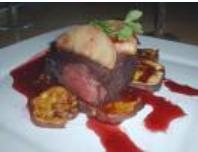
“It’s gamey — think beef plus arm pit,” says Freya Petersen, GlobalPost’s Breaking News Editor and our resident Australian staffer. “It needs to be cooked through but not over-cooked.”
“To me, it smells like pet food because we used to feed it to our dog and cat,” she adds.
Environmentalists and animal rights groups are also worried about the plan.
Australia’s kangaroo population “can’t even deal with the domestic and European consumption,” Nikki Sutterby of the Australian Society for Kangaroos told the New York Times. “How would it deal with a country as large as China starting to eat kangaroo meat?”
The kanga-meat crowd down under, however, remains undeterred.
“I’d expect us to be putting product into China at some time this year,” Kelly told the New York Times, adding that he expected China “at some stage to be a larger market than Russia ever was.”
.
[Source: ‘Would you eat thsi animal?’, by Thomas Mucha, 20110415, ^http://www.globalpost.com/dispatches/globalpost-blogs/macro/kangaroo-australia-china]
.
.
‘It sure ain’t Easy being Green! About the Kangaroo Coalition coordinator!’
by John Watson, Spectator News Magazine
.
‘Pat O’Brien became a greenie, and activist, in Condobolin 35 years ago when he saw kangaroos herded together, shot and clubbed to death. Until that moment, he had been “normal”.
The meatworker, who was working his way around Australia with his wife and three kids, did not think about the environment, probably dropped paper on the ground and just lived his own life. However, because of that sight of kangaroos being slaughtered, he has spent the next 35 years fighting for animals and the environment….’
READ MORE: ^http://www.kangaroo-protection-coalition.com/coordinator.html
.
Meanwhile, the Queensland Government tries to legitimise wildlife poaching by using euphemistic language…’The Department’s Commercial Macropod Management Program administers the commerical harvest of macropods in Queensland.’
.
^http://www.derm.qld.gov.au/wildlife-ecosystems/wildlife/wildlife_permits_and_licences/kangaroo_harvesting.html
‘It’s a poor farm that can’t sustain a few kangaroos.’
.
.
Further Reading:
.
[1] ‘ A Shot in the Dark‘, ^ http://www.wildlifeadvocate.com/pdf/a_shot_in_the_dark.pdf , [ Read Report]
[2] National Kangaroo Protection Coalition, ^ http://www.kangaroo-protection-coalition.com/
[3] THINKK (The Think Tank for Kangaroos), University of Technology Sydney, ^ http://thinkkangaroos.uts.edu.au/
[4] No Kangaroo Meat website, ^ http://www.nokangaroomeat.org/
[5] ‘ Kangaroo Harvesting under the spotlight‘, ABC TV ‘730 Programme’, 20110713, ^ http://www.abc.net.au/7.30/content/2011/s3268904.htm
[6] Australian Society For Kangaroos, ^ http://www.australiansocietyforkangaroos.com/not_so_green.html
[7] Read the original comments to the initial article by Tigerquoll on the CanDoBetter.net website: ‘ Kangaroo rapers of Mitchell (Qld) and the E.coli time bomb‘
.
.
Tags: Anna Bligh, Charleville, E. coli, export for human consumption in fancy restaurant, kanga meat, Kangaroo Industry Association of Australia, kangaroo meat, kangaroo meat hygiene, kangaroo pet food, kangaroo poaching, kangaroo slaughter trade, Mitchell, Queensland, Rolf Harris, roo raper, roo shooter, Russian kangaroo meat, THINKK, Warrego Highway, wildlife poaching
Posted in Kangaroos and Macropods, Threats from Poaching and Poisoning | No Comments »
Add this post to Del.icio.us - Digg
Tuesday, October 25th, 2011
The following article was initially posted by Tigerquoll as a comment on the Tasmanian Times 20100202:
.
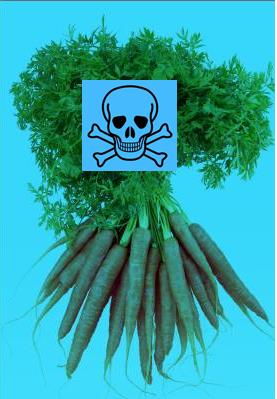 1080 ‘blue carrots’ 1080 ‘blue carrots’
.
Six years ago, the Tasmanian Greens tabled their Agricultural and Veterinary Chemicals (Control of Use) Amendment (Ban 1080) Bill 2004 to ban the use of 1080 poison (sodium monofluoroacetate) against native wildlife. But it excluded “persons directly employed with the Fox Task Force, up until the period ending 1 October 2006.”
‘Fox Task Force‘ …what a scam! Talk about dodgy jobs for mates at DPI. All they come up with is shit. It could be Drop Bear shit! They may as well be called it the Drop Bear Task Force and dress ’em up in black special forces attire and give ’em paint guns.
1080 must be banned in Tasmania outright including this fraudulent drop bear mob. I’d like to see an FOI on how much the taxpayer has funded them since they were set up. $10 million? We could have found a cure for the Devil’s face tumor or housed hundreds of homeless youth in Tasmania by now.
Tasmania’s “Department of Primary Industries and Water is the only importer of 1080 into Tasmania and only authorised officers of the Department handle the poison.” So the 1080 buck stps with DPI. DPI’s head needs to show cause, whoever the latest ‘acting’ secretary is! DPI has had so many name changes, ministers and bosses, DPI staff must be running the show. GM Environment was Warren Jones in October, so he can take the can, unless he’s been sacked as well.
According to DPI’s latest annual report, its Environment branch has a mission “to ensure best practice in environmental management and pollution control”…blah blah blah.
Well best practice in environmental management is exercising the precautionary principle, which in lay terms means if you’re not sure don’t intervene. Well ban 1080 until you can deliver a fox to the Hobart Town Hall!
.
.
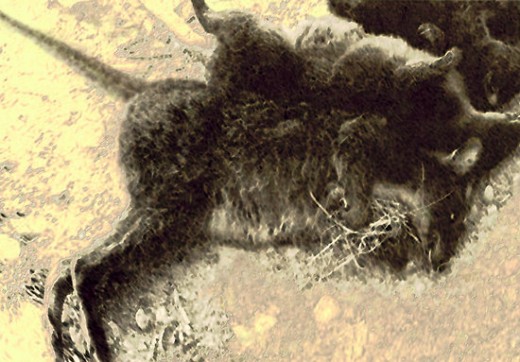 Tasmanian native Pademelons killed by 1080 poison
Source: http://www.redbubble.com/people/cradlemountain/art/3160948-why-is-1080-poison-not-good-for-tasmania-and-the-world Tasmanian native Pademelons killed by 1080 poison
Source: http://www.redbubble.com/people/cradlemountain/art/3160948-why-is-1080-poison-not-good-for-tasmania-and-the-world
.
‘By the year 2000, the Tasmanian Government poisoned 30 million native animals by allowing forest and farming industries to kill all marsupials (other species were sacrificed along with the slaughter).
Here I was collecting bodies and found nine different species affected, dead. This little female wallaby was clasping onto grass and had made a circle in the ground while dying in pain. I could not get the grass out of her little paws.’
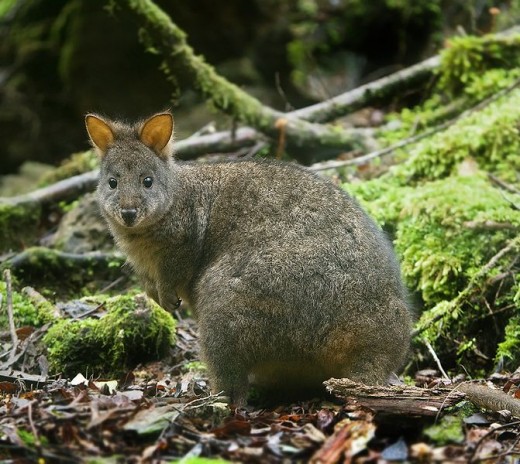 A live and healthy native Tasmanian Pademelon A live and healthy native Tasmanian Pademelon
.
.
1080 is immoral
.
1080 (sodium monofluroacetate) is a cruel and indiscriminate poison used to ‘remove’ unwanted populations of animals.
Banned in most countries, 1080 is still used liberally throughout Australia and New Zealand to control so-called ‘pest’ species, and reduce ‘browsing damage’ caused by native animals on private land. Its use is indiscriminate, which means that it kills not just the target feral animals but every animal in the area that eats off the forest floor.
1080 poison is a slow killer. When ingested (usually through baited food) the animal suffers a prolonged and horrific death. Herbivores take the longest to die – up to 44hrs, while carnivores can take up to 21hrs before finally succumbing to final effects of the poison. The speed of death is dependent on the rate of the animals metabolism.
.
A Slow & Horrific Death
.
Witnesses to the deaths of herbivorous animals, such as macropods, have reported:
“Affected wallabies were sometimes observed sitting hunched up, with heads held shakily just above the ground. Generally they appeared non-alert and ‘sick’, with shivering or shaking forelimbs and unsteady balance. Most individuals then experience convulsions, falling to the ground and lying on their backs and sides, kicking and making running motions with their hind legs before dying. Many individuals also ejaculated shortly before death, and, with others, exuded a white froth from their nostrils and mouth.”
Carnivorous animals such as dingoes, dogs, foxes, and cats become very agitated, as they tremble, convulse and vomit.”
[Source: ‘The World League for Protection of Animals’, ^http://wlpa.org/1080_poison.htm]
.
Also, 1080 is indiscriminate, it kills all carnivores including Devils, and endangered quolls and dogs.
“Under state poisons legislation, 1080 is a Schedule 7 poison and is available only to specialised or authorised users who have the skills necessary to handle it safely. Under the Agricultural and Veterinary Chemicals Code Regulations 1995, products containing 1080 are also declared to be ‘Restricted Chemical Products’. As such, the products can only be supplied to or used by ‘authorised person(s)’. Individual states set the authorisation criteria taking the APVMA’s and state regulatory requirements into account.
Despite these regulations, poisoning of non-target wildlife and domestic pets is common and farm animal species can also be at risk. In NSW, an estimated 14,000 baits are laid per Rural Land Protection Board per annum, and 2002-2003 figures on 1080 use released by the Tasmanian Government indicated Forestry Tasmania used 23 per cent, farmers 47 per cent, and private forestry 30 per cent. In the same year, the Tasmanian Government also released statistics stating that 97,000 wallabies and brushtail possums had been poisoned by 1080, primarily through baiting programs aimed at targeting browsing and grazing native animals as part of forestry management. Phasing out of 1080 in Tasmanian forests has since commenced.
Canines are particularly susceptible to 1080 and the lethal dose for dogs has been calculated at 0.05mg/kg. Once consumed, it is rapidly absorbed from the gastrointestinal tract, impairing cellular respiration through disruption of the citric acid cycle with resultant CNS anoxia and cardiovascular disturbance. 1080 can also be absorbed from the respiratory tract and through cuts and abrasions.
1080 has no specific antidote and even in animals treated symptomatically, is usually fatal.”
[Source: ‘The Veterinarian’, ^http://www.theveterinarian.com.au/features/article685.asp]
.
1080 poison is as vicious as laying 19th Century steel jaw traps around Hobart parks, or giving kids air rifles to play with at school.
It is incumbent on the public’s trust in the ethics and responsibility of the Tasmanian Government’s Department of Primary Industries, Parks, Water and Environment (etc) to show proof of foxes or else ban 1080 poison outright across Tasmania.
Else it will be some perturbed fox myth that ends up killing Tasmania’s devils, quolls, wallabies, the forester kangaroo, just like the 19th Century myth that Thylacene’s killed farmers’ sheep so deserving their redneck extinction.
The DPI always claims recent physical evidence of foxes. If so, then show recent proof to the public, not old specimen carcasses from a zoo. Show the Tasmanian public also independent zoological proof that using 1080 cannot harm non-target species!
.
Victoria following Tasmania’s backward example
.
‘Authorised persons in Victoria can now purchase 1080 pest animal bait products from accredited retailers or licensed perishable bait manufacturers.
Two categories of 1080 pest animal bait products are now available in Victoria:
- Australian Pesticides and Veterinary Medicines Authority (APVMA) registered 1080 pest animal bait products (‘shelf-stable bait’) such as dry oats and dried meat baits. Retailers of these baits must have Agsafe Guardian 1080 accreditation.
- Perishable 1080 pest animal bait products (‘fresh’ bait) such as carrot and liver, manufactured using 1080 aqueous solution registered with the APVMA for that purpose. These bait products are not registered with the APVMA but are supplied under an APVMA permit. The manufacturer of these bait products is also the retailer. These persons must meet specific training and accreditation requirements and be licensed by the Department of Human Services (DHS).
In order to purchase 1080 pest animal bait products you need to complete a Course in Minimising the Risks in the Use of 1080 Pest Animal Bait Products for Vertebrate Pest Control and obtain a 1080 endorsement to your Agricultural Chemical User Permit (ACUP).
These changes are designed to make it easier for you to purchase 1080 pest animal bait products. They enable users to purchase 1080 pest animal bait products from local accredited retailers during normal business hours, enable a greater range of 1080 pest animal bait products to become available to users, and make the manufacture, supply and use of 1080 pest animal bait products safer.’
[Source: ^http://dpi.vic.gov.au/agriculture/farming-management/chemical-use/agricultural-chemical-use/bait-system, accessed 20111025]
.
.
South Australia following Tasmania’s backward example
.
‘The Controlled Substances (Poisons) Regulations,1996 allows land owners access to 1080 baits (sodium fluoroacetate) for the control of rabbits, foxes and dingoes/ wild dogs on their own property.
The current Label, Directions for Use and Material Safety Data Sheet are reproduced here for each bait product.
The Directions for Use include the following documents:
Record of notification of neighbours before commencement of baiting programs
Checklist to be used when a person first receives baits
Poison laid sign design
Authorisation to use the baits requires the land owner (or their agent nominated in writing) to sign an Approval to Possess 1080 Bait form supplied by a Natural Resources Management officer. Non-compliance with the Directions for Use is an offence under the Controlled Substances Act, 1984 and the Agricultural and Veterinary Products (Control of Use) Act, 2002.
For information on the supply and possession of 1080 bait, contact the Environmental Health Branch, Department of Health on (08) 8226 7117 or (08) 8226 7137.
For information or advice on suspected cases of misuse of 1080 bait products or to report that non-target animals may have been poisoned by 1080, contact PIRSA Biosecurity – Rural Chemicals on (08) 8226 0528.
[Source: ^http://www.pir.sa.gov.au/biosecuritysa/nrm_biosecurity/pest_animal/1080_use_in_sa, accessed 20111025]
.
.
Further Reading:
.
[1] ‘Another bogus fox claim‘, by Ian Rist, 20100201, Tasmanian Times, ^http://tasmaniantimes.com/index.php?/weblog/article/another-bogus-fox-claim/
[2] ‘Code of Practice for the Use of 1080 for Native Browsing Animal Management‘, Tasmanian Department of Primary Industries, Parks, Water and (by the way) Environment, etc.
[3] ‘ 1080 Poison‘, The World League for Protection of Animals, ^ http://www.wlpa.org/1080_poison.htm
[4] ‘ 1080 Poison – the all purpose killer‘, Animal Liberation, ^ http://animal-lib.org.au/subjects/culling-and-pest-control/20-1080-poison.html
[5] ‘ STOP 1080 POISON. New Zealand Must Ban This Poison!‘, 20090425, ^ http://www.openureyes.org.nz/blog/?q=node/1359
[6] Indiscriminate Aerial Baiting in New South Wales, ^ http://www.dpi.nsw.gov.au/__data/assets/pdf_file/0003/57279/rab-003.pdf
[7] Tasmanian Farming – 1080 Poison
.
Thursday, October 13th, 2011
If you go down into the woods today you’re sure in for a big surprise…but in Tasmania’s South-West it ain’t no teddy bear’s picnic.
One has to first get past the many infamous locked gates. Forestry Tasmania (aka the State-sanctioned corporate logger) is sure to have locked its steel gates for very good reason – Forestry Tasmania doesn’t want the public to know the truth about what it is doing to Tasmania’s remaining wild forests.
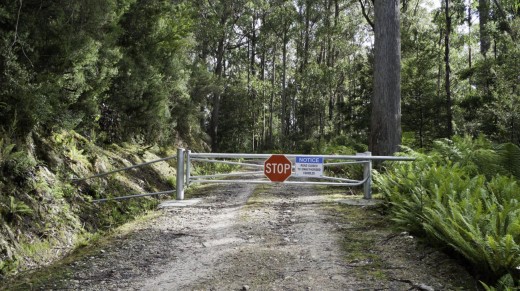 Forestry Tasmania’s locked gate on the public road to the top of Mount Tim Shea
(Suspiciously this public access road was deemed unfit for public travel coincidentally around the same time as Forestry Tasmania opened its ‘Adventure Hub’ in Maydena,
and equally coincidentally one of the hills they charge people for a ride to the top from reads ‘Adventure Hub’).
(Photo by Alan Lesheim) Forestry Tasmania’s locked gate on the public road to the top of Mount Tim Shea
(Suspiciously this public access road was deemed unfit for public travel coincidentally around the same time as Forestry Tasmania opened its ‘Adventure Hub’ in Maydena,
and equally coincidentally one of the hills they charge people for a ride to the top from reads ‘Adventure Hub’).
(Photo by Alan Lesheim)
.
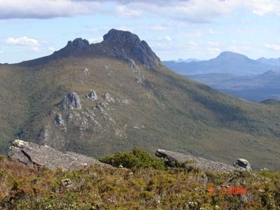 Rugged Mount Tim Shea, South-West Tasmania Rugged Mount Tim Shea, South-West Tasmania
Photo by Forestry Tasmania
^http://www.forestrytas.com.au/topics/2008/06/maydena-adventure-hub-opportunities
.
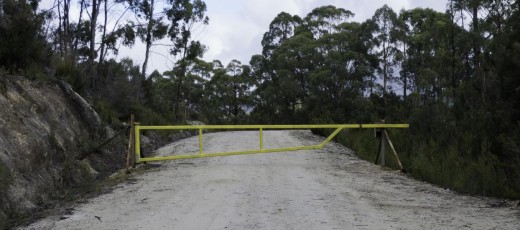 Locked Gate on Five Road in the Upper Florentine Locked Gate on Five Road in the Upper Florentine
(connects to Cook’s Track which enters the Gordon River Road short of Camp Flozza)
(Photo by Alan Lesheim)
.
Forestry Tasmania has hundreds of these padlocked gates throughout Tasmania’s wild forests.
The Wilderness Society’s spokesperson Amanda Sully said “Forestry Tasmania have a locked boom gate over the Huon Valley Wilderness and are refusing entry. This is just one of hundreds of gates on forestry roads in Tasmania.
“It’s very clear who is locking up the forests. People are sick and tired of seeing log truck after log truck coming from the clear felling behind these padlocked gates.
These are publicly-owned forests.
Forestry Tasmania is supposed to manage them for the benefit of all Tasmanians, not just the loggers” Ms Sully concluded.
.
[Source: ‘Forestry Tasmania – Locking up our forests‘, ^http://www.wilderness.org.au/campaigns/forests/19980924_mr
.
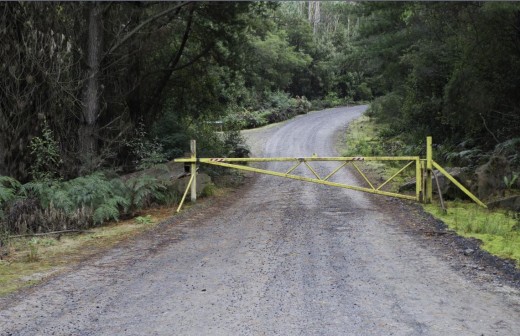 Forestry Locked Gate on Blue Road, northern section of the Upper Florentine Valley Forestry Locked Gate on Blue Road, northern section of the Upper Florentine Valley
(Photo by Alan Lesheim)
.
.
Author Anna Krien was on a quest for the truth described in her revealing expose book of 2010 into what’s stihl happening in Tasmania’s wild forests:
~
‘Most people travelling through Tasmania will never know of the long-running hide-and-seek taking place in the labyrinth of logging roads beyond the bitumen.
Sightseers walk among 300-year-old trees, some of them 90 metres tall, in the Styx Big Tree Reserve, chainsaws can be heard in the distance.
The road into this attraction is lined with stage sets of wilderness.
At the rise of a hill, just before the nose of the car tilts downwards, passengers might glimpse a balding peak, a fleeting insight into the world behind the verge.’
~
[Source: ‘Into the Woods: The Battle for Tasmania’s Forests‘, 2010 by Anna Krien pp.25-26, published by Black Inc. ^http://www.blackincbooks.com/books/woods, includes video interviews].
.
So, this Editor, half way through the book, last month flew down to Hobart, hired a car and retraced the author’s journey into Tasmania’s South-West …
.
 Driving west along the old Hydro Electrical Commission’s (HEC) Gordon River (Access) Road,
through Forestry’s logging town of ‘Westerway’ Driving west along the old Hydro Electrical Commission’s (HEC) Gordon River (Access) Road,
through Forestry’s logging town of ‘Westerway’
.
Noticeably, when driving out of Hobart I passed clearly wealthy residential suburbs, yet driving along the Gordon River Road these few isolated hamlets are not wealthy. Their construction mostly seems temporary like mining companies would construct while the mine delivers. The highway through the hamlets of Westerway, Fitzgerald and Maydena seems only for forest access, not for community.
I parked the car and walked through Maydena.
There is only the odd person out and about. The place seems impoverished – one small primary school, a notable lack of shops, lack of amenities, and little sign of any vibrant community.
It’s as if the profits from logging have driven right through the guts of these local villages and on to big corporations eastward.
.
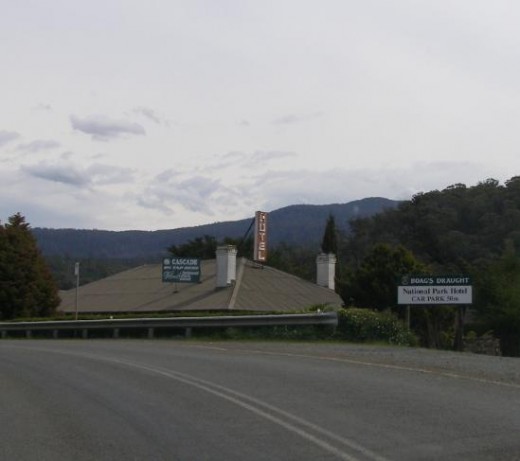 Past the National Park Hotel
where Tasmania’s champion wood-chopper ‘Big Dave’ holds pride of place above the pub’s fire place. Past the National Park Hotel
where Tasmania’s champion wood-chopper ‘Big Dave’ holds pride of place above the pub’s fire place.
.
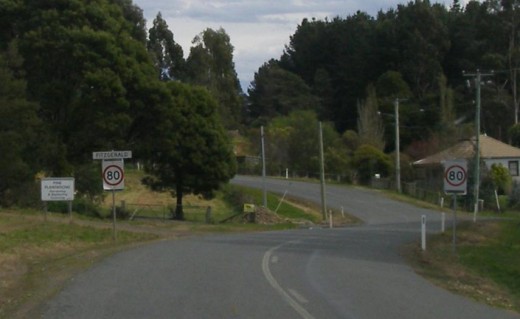 Driving through Forestry’s old logging town of ‘Fitzgerald’
. Driving through Forestry’s old logging town of ‘Fitzgerald’
.
.
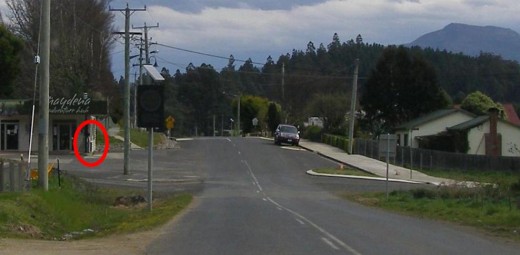 Driving through the old logging town of ‘Maydena’
– a closed so-called ‘Adventure Hub’ on the left, yet its diesel bowser (circled) open for Forestry Tasmania vehicles and observed in used by Editor 20110928. Driving through the old logging town of ‘Maydena’
– a closed so-called ‘Adventure Hub’ on the left, yet its diesel bowser (circled) open for Forestry Tasmania vehicles and observed in used by Editor 20110928.
.
Reminiscent of Australia’s 1850s Gold Rush, Tasmanian folk would have been lured west by Forestry to the promise of bountiful tall timber delivering reliable logging income and the promise of building personal wealth.
But along the Gordon River Road there is a stark absence of Forestry wealth. Instead it seems Forestry has abandoned these Gordon River Road communities.
What Forestry has done is to sell out Tasmania’s traditional woodcraft industry for short term profit from flogging quality Tasmanian hardwood as cheap asian woodchips, destroying Tasmania’s forests timber communities in the process. Then Gunns got greedy and Tasmania’s timber reputation has deteriorated thereafter.
Now Forestry Tasmania are clearfelling and selling out Tasmania’s rare forests to the asians direct, to the likes of Ta Ann. Forestry Tasmania is no more than a corporate pimp of Tasmanian rare forest heritage.
.
“The road into this attraction is lined with stage sets of wilderness.”
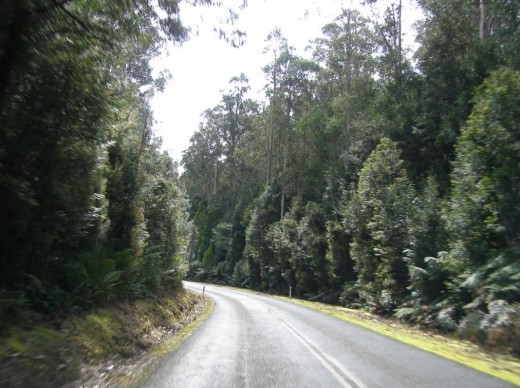 Driving further west along the HEC Gordon River Road
– bulldozed in 1964 through 64km of pristine wilderness forest by the Hydro Electric Commission, and
funded by the then Menzies federal government at a cost of £2.5 million (likely twenty times that in today’s terms – i.e. $50 million.
. Driving further west along the HEC Gordon River Road
– bulldozed in 1964 through 64km of pristine wilderness forest by the Hydro Electric Commission, and
funded by the then Menzies federal government at a cost of £2.5 million (likely twenty times that in today’s terms – i.e. $50 million.
.
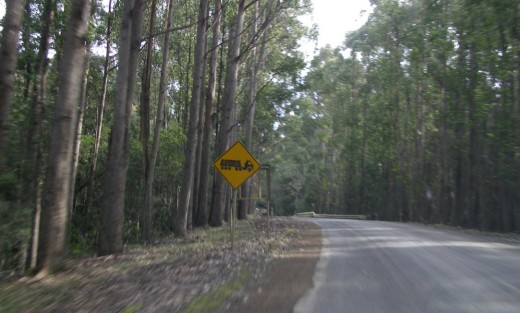 Gordon River Road – signposted logging country Gordon River Road – signposted logging country
.
“At the rise of a hill, just before the nose of the car tilts downwards, passengers might glimpse a balding peak”
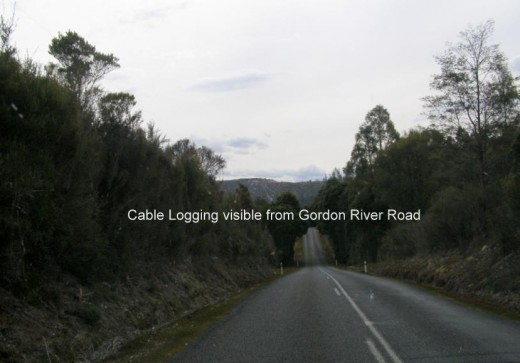 The balding peak of Forestry Tasmania’s cable logging…’a fleeting insight into the world behind the verge’.
(Photo by editor 20110928 while on Gordon River Road heading west) The balding peak of Forestry Tasmania’s cable logging…’a fleeting insight into the world behind the verge’.
(Photo by editor 20110928 while on Gordon River Road heading west)
.
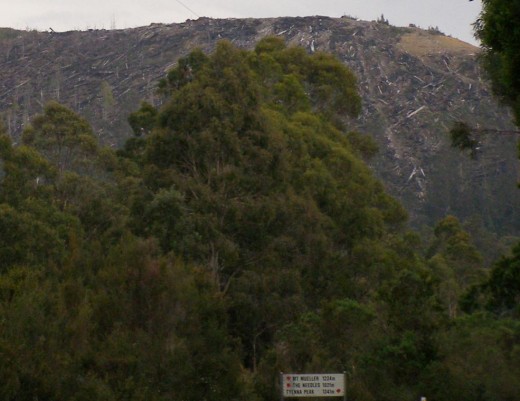 An entire hill of wild Tasmanian forest savagely cabled logged bare by Forestry Tasmania
Tourists can now see this from Gordon River Road.
(Photo by editor 20110928. Click photo to enlarge.)
An entire hill of wild Tasmanian forest savagely cabled logged bare by Forestry Tasmania
Tourists can now see this from Gordon River Road.
(Photo by editor 20110928. Click photo to enlarge.)
.
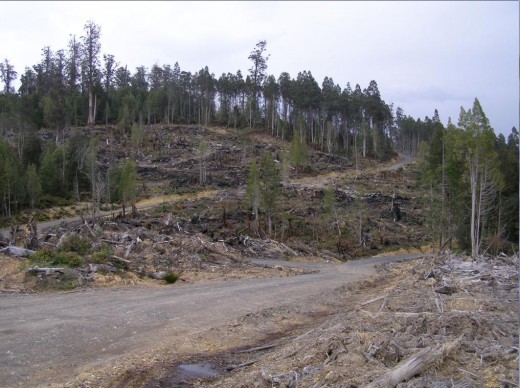 Beyond the lock gates lies the ecological holocaust
(Photo by editor 20110928. Click photo to enlarge.) Beyond the lock gates lies the ecological holocaust
(Photo by editor 20110928. Click photo to enlarge.)
.
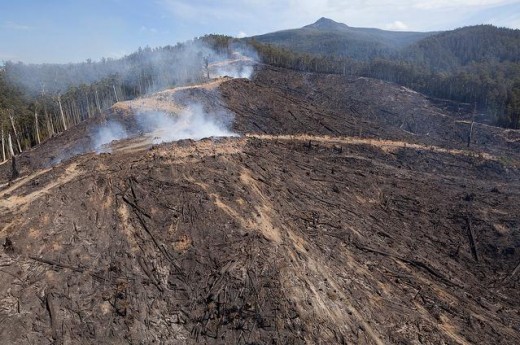 Styx Valley Holocaust
(Photo by Rob Blakers) Styx Valley Holocaust
(Photo by Rob Blakers)
.
 Tasmania’ s Styx Holocaust
September 2011 (Photo by Alan Lesheim)
Tasmania’ s Styx Holocaust
September 2011 (Photo by Alan Lesheim)
.
 Forestry Tasmania’s Killing Fields
Forestry Tasmania’s Killing Fields
.
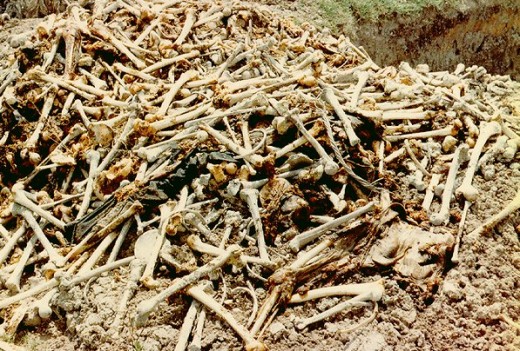 Cambodia’s Khmer Rouge Killing Fields
(Human mass murder comparable to Tasmania’s mass forest murder
– both crimes consistently against life) Cambodia’s Khmer Rouge Killing Fields
(Human mass murder comparable to Tasmania’s mass forest murder
– both crimes consistently against life)
.
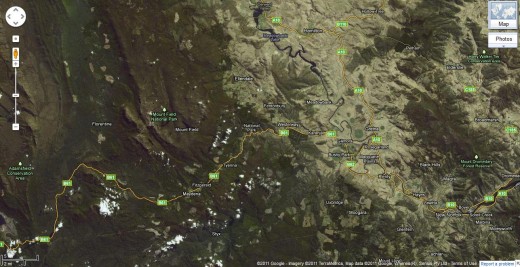 Google Maps (September 2011) satellite view of the forest rape by Forestry Tasmania
.
Google Maps (September 2011) satellite view of the forest rape by Forestry Tasmania
.
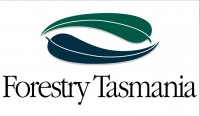 . .
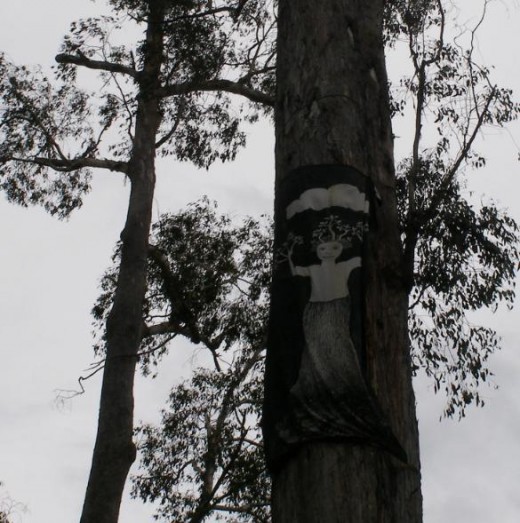 Camp Flozza’s symbolic goddess of the ancient Florentine Forest
~ eco-raped by Forestry Tasmania in its January 2009 raid
Camp Flozza’s symbolic goddess of the ancient Florentine Forest
~ eco-raped by Forestry Tasmania in its January 2009 raid
.
 And they wonder why the people protest and are prepared to be arrested?
(Photo of forest defender being arrested at Forestry Tasmania’s police raid on Camp Flozza,
Upper Florentine Valley, 13th January 2009) And they wonder why the people protest and are prepared to be arrested?
(Photo of forest defender being arrested at Forestry Tasmania’s police raid on Camp Flozza,
Upper Florentine Valley, 13th January 2009)
.
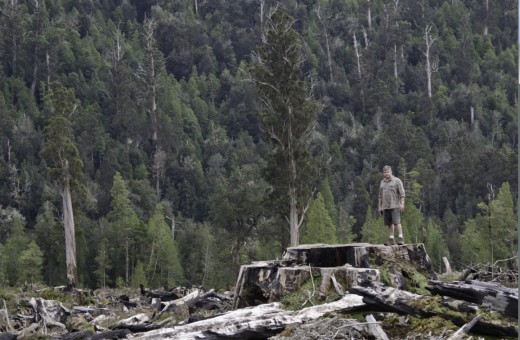 Styx Valley Holocaust by Forestry Tasmania, September 2011
(Photo of editor 20110928. Click photo to enlarge.)
Styx Valley Holocaust by Forestry Tasmania, September 2011
(Photo of editor 20110928. Click photo to enlarge.)
.
.
Forestry Tasmania padlocks gates 10 kilometres from clearfell around a protected Wedge-tailed Eagle nest
[Source: ‘Loggers breach eagle nest protection laws again‘, Bob Brown, 20090827, ^http://bob-brown.greensmps.org.au/category/issues/environment/forestry/wielangta]
‘In the breeding season, a clear felling operation in Tasmania’s wild Upper Huon Valley has breached guidelines by smashing down forests next to an endangered Tasmania’s Wedge-tailed eagles’ nest. The Tasmanian Wedge-tailed eagle, with wingspan up to 3 metres, are one of the Earth’s 6 largest eagle species.
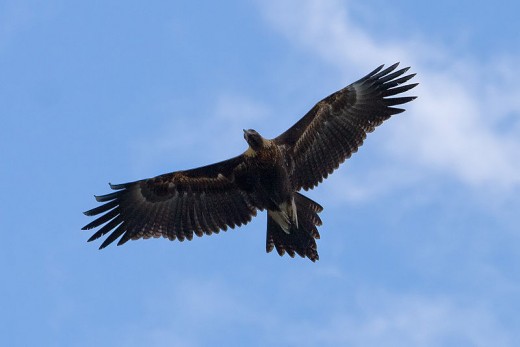
“After repeated controversies about woodchip operations burning or destroying eagle nests and causing failure of nesting because of bulldozers and chainsaws operations near nests, this failure of protection in the Huon is inexcusable. It makes a mockery of logging industry propaganda,” said Australian Greens Leader Bob Brown.
“The Ministers for Forestry and Environment who are responsible for Australia’s rare and endangered species don’t know, and don’t act in any helpful way.”
“It is as if the Howard Government never left office. These ministers have washed their hands of their role in the Wedge-tailed eagles’ fate. Logging laws in Tasmania state that a minimum of 10 hectares be left around an eagle’s nest,” said Senator Brown.
Forestry Tasmania has erected locked gates 10 kilometres from the nest logging site preventing public or media inspection.’
.
Footage of the logged area and nest available here (on YouTube):

.
.
Meanwhile Forestry Tasmania on its ‘Adventure Forests‘ website promotes its ‘Top of the World Tour‘ from Maydena…

…’Go wild where eagles soar…Make the escape to the Eagle’s Eyrie on a Top of the World Tour.You’ll experience all the fun of the Railtrack Rider as you travel into the heart of the forest to explore long-abandoned bush heritage, before emerging to an alpine wonderland and an eagle’s eye view over the Tasmanian wilderness. There’s plenty of time for indulgence as well, with an individually-prepared gourmet lunchbox and fine regional wines enjoyed in the fireside comfort of the Eagles Eyrie.’
^http://adventureforests.com.au/maydena
.
.
‘The real voyage of discovery consists not in seeking new landscapes
but having new eyes’
~ Marcel Proust, French novelist
Tags: Anna Krien, Cable Logging, Camp Flozza, deforestation, Fitzgerald, Florentine Valley Holocaust, Forestry Holocaust, Forestry Locked Gates, Forestry Tasmania, Gordon River Road, having new eyes, Into the Woods, Maydena, Maydena Adventure Hub, Mount Tim Shea, National Park hotel, Styx Big Tree Reserve, Styx Forest, Styx Valley, Styx Valley Holocaust, Ta Ann, Tasmania, Tasmania's Ancient Forests, Tasmania's South West, Tasmania's Wild Forests, Upper Florentine Forest, Wedge-tailed Eagle, Westerway, wild forests
Posted in Eagles, Tasmania (AU), Threats from Deforestation, Threats to Wild Tasmania | No Comments »
Add this post to Del.icio.us - Digg
Thursday, September 15th, 2011
The following article was published on CanDoBetter.net today (20110915) by wildlife ecologist and biologist, Hans Brunner, under the title: ‘A planned slaughter of endangered wildlife’
.
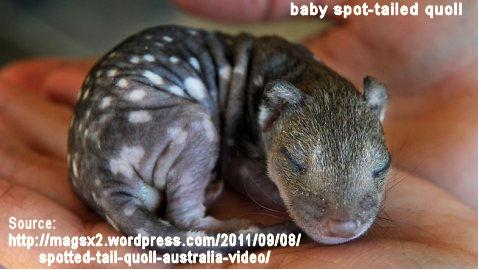
The Victorian Government plans to drop 1080 poison bait from an aircraft into forests could result in the extinction of the already critically endangered Spotted-tailed Quoll.
The purpose of this antiquated and vandalistic method is to poison wild dogs. Why is the Victorian Government using old, dangerous methods? This is like re-introducing the use of DDT. It is now a double disaster; all Ted Baillieu has to do now is to aerial bait to kill wild dogs in order to protect the cattle he allowed to go back into the mountains! Spot-tailed quolls and other dasyurids are meat eaters as well as some species of possums, reptiles, bandicoots and birds. They would be all at a serious risk of being poisoned. Further more, most of this bait would be wasted because of the dogs not being able to find them and this is where non-target animals will rather find and eat them. Baits have therefore to be placed only in places which dogs frequently use, along forest tracks.
.
More effective methods
There is a well researched and efficient method for the poisoning of wild dogs and foxes. It is a target specific bait station system which is successfully used throughout Victoria. Bait stations are placed along forest tracks where activities of dogs are observed.
A bait station consists of a mound of soil about 20 cm high and one meter in diameter. An un poisoned bait (free feed) is buried in the center of the mound about 10cm deep with some SFE lure placed on top. When the bait has been dug up and eaten, a check is made, with some experience, to assess whether a dog or fox took the bait. If satisfied that a target species took the bait it can be replaced with a poison bait. If it appears that a quoll or an other non-target animal may have taken the free feed bait, continue free feeding that station to keep the quoll and others away from a poison station (about 2 km away) or eliminate that station.
.
This is the only responsible way to poison dogs and foxes. Even better, it will be of great benefit to not only the quolls by removing the competition by dogs and foxes of their natural prey species, but also for the survival of Kangaroos, wallabies, bandicoots, possums, echidnas etc.
.
Biologist’s experience of alternatives
I have researched and tested this system in 700 square km of forest between Gembrook and Neerim and found it most effective and efficient. I have also introduced it in NSW National Parks where it was recognized as “The dog baiting stations proposed by Hans are the best practical suggestion to date. With the implementation of the bait stations, properly maintained and serviced at the appropriate times, there would appear to be NO reason to allow the continued use of aerial baiting” and, “Poisoning using the buried bait technique is still proving extremely target specific, with dogs and foxes being the only species killed”.
.
Do it the right way and wildlife return
Barbara Triggs, an eminent naturalist stated after poisoning wild dogs and foxes and using the bait station system on her property in Croajingolong National Park, East Gippsland:
.
“At no time has there been any evidence that a bait has been taken by a non-target animal. In the past year the numbers of native animals seen on the property have increased startlingly. The Red-necked Wallabies, who’s group was here in low numbers, have increased markedly from five individuals to now at least fourteen. The most surprising increase has been in the population of Long-nosed Bandicoots. The Dusky Antechinus, Swamp Rats, Water Rats, Sugar Gliders and several species of ground-nesting birds and also species of owls are much more in evidence than ever before.”
.
With all this evidence, this non specific and irresponsible aerial baiting must be immediately stopped.’
Hans Brunner
Wildlife biologist
Sept 2011
Tuesday, September 13th, 2011
The following letter to the editor appeared in the Blue Mountains Gazette newspaper on page 12 of 10th August 2011, written by Rose and Brett Everingham of Lapstone, Blue Mountains, Australia.

‘Native Wildlife Alert’
.
‘On the evening of Tuesday July 29 a beautiful Echidna was unfortunately hit by a car outside our house.
We would like to publicly thank the three lovely young gentlemen who stopped to assist us as we moved it off the road, and then rang WIRES.
It was a particularly upsetting experience, no one wants to see any creature hit by a car, especially our native wildlife. The young gentleman who hit the Echidna was understandably distressed, as it is not something you would usually expect to see, and we reassured him that it was simply an accident.
It is a timely reminder though to take care when driving at night, particularly on Governors Drive which is often used as a race track for some drivers. Unfortunately the Echidna could not be saved. Once again a thanks to the young gentleman who stayed with my husband and son whilst they buried it.
Whilst a sad experience, it brought relief to know that Lapstone still has such beautiful native wildlife existing amongst us in the bush.’
.
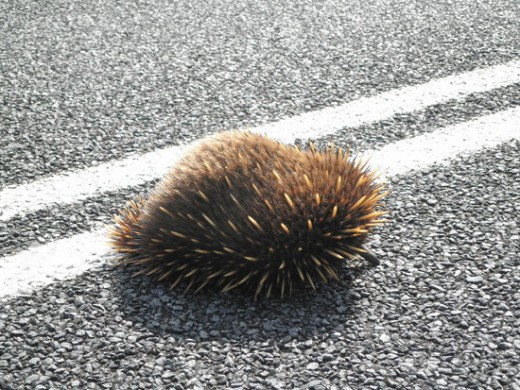
.
.
Editor’s Comments:
.
1. The killing of a native echidna by a driver of a car is an horrific tragedy for the echidna and its likely dependent mate and offspring, which were not mentioned. Each killing of adult native wildlife harms the viability of the local population of that species in the area.
2. Rose and Brett are right to have done what they did and it is valuable to the local community that Rose has taken the trouble to share this tragic event via her letter in the local paper.
3. The cause of the Echidna’s death was that the car driver was driving too fast to prevent killing it on the road. Most drivers drive too fast and are not competently trained to drive for the conditions.
It could have been a child killed while running on to the road. I am sure the local paper would have had more than allowing Rose’s letter, which reflects our culture that human life holds selfishly somehow higher values than wildlife. One may call this ‘speciesism’, a term few are aware.
4. Echidna habitat was there many thousands of years before European colonists destroyed its environment and selfishly carved a road through its habitat, with no care for any native wildlife values.
5. Such roads as Governors Drive, whether constructed by local Blue Mountains Council or larger ones by the Roads and Traffic Authority (RTA), not only destroy native vegetation and wildlife habitat in their construction, as well as allowing sediment pollution of downhill watercourses; no respect is paid to the inevitable road death consequences caused by vehicles using the road. The underlying reason is that human values for wildlife are so low across the community that there is hardly any call for wildlife protection from the threats of road making and its consequential traffic menace. Worse is that perverted attitudes toward wildlife and deviant behaviour prevail to the extent that the killing of wildlife on our roads is disparagingly dismissed as ‘roadkill’. If the same term were applied to pedestrian deaths on our roads, there would be an uproar by extreme humanists.
6. No attempt is made by road builders (local council or the RTA) to facilitate separation of ground dwelling native wildlife from the inevitable risk of death from introduced road traffic. Some roads across Australia have wildlife fencing to prevent native animals such as wallabies, wombat and Echidnas from accessing the road. Others factor wildlife corridors into the design of roads that destroy wildlife habitat. It is an indictment on both the Blue Mountains Council and the RTA that there are no wildlife fences or wildlife corridors throughout the Blue Mountains.

7. That Rose wrote “it is not something you would usually expect to see” is a sad indictment on the demise of wildlife populations across the Blue Mountains since colonial conquest, such that now people living in the Blue Mountains do not expect to see wildlife any longer. Villages like Lapstone have become so urbanised that they are all but outer suburbs of Sydney. The natural bush environment has been lost to a sterile parkland to suit the needs of humans. The values of native wildlife and their habitat continue to be ignored by humans who live and drive through the Blue Mountains and by custodial government authorities – Blue Mountains Council, NSW Department of Environment (etc), Australian Department of Environment (etc).
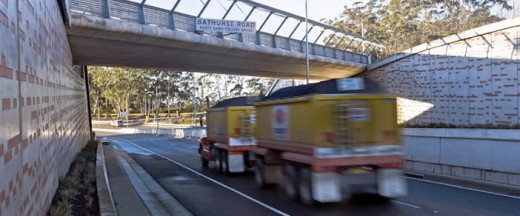 . .
Yet, despite the arrogant disregard for wildlife values across the Blue Mountains, especially at the human interface, other regions take a more proactive view, such as in Sydney’s Northern Beaches region.
.
 Uncontrolled speeding on Australian roads Uncontrolled speeding on Australian roads
.
Related Articles:
.
‘Wallaby becomes roadkill after fence holed’
.
by Brenton Cherry, 20110112, Many Daily, ^http://manly-daily.whereilive.com.au/news/story/wallaby-becomes-roadkill-after-fence-holed/
 Eira Battaglia, Mandy Beaumont, Niamh Kenny,
Cassie Thompson and Elvira Lanham at the damaged fence.
(Photo by Virginia Young) Eira Battaglia, Mandy Beaumont, Niamh Kenny,
Cassie Thompson and Elvira Lanham at the damaged fence.
(Photo by Virginia Young)
.
‘A hole has been cut in the wildlife-proof fence along Wakehurst Parkway at Oxford Falls, leading to at least one wallaby being killed. The death – discovered by Jacqui Marlow from the Northern Beaches Roadkill Prevention Group – was the first along the stretch of road since the fence was installed.
“Why would anyone cut a hole in the fence?” she said. “I found the hole after seeing a dead wallaby in the fence area.
“It’s the first one killed in the fence area since it was installed, which shows that it works.”
Ms Marlow said she had become disenchanted by the actions of some people.
“At the moment my opinion of humans is not very good, especially when it comes to their attitude to nature,” she said. “I’m really tired of dealing with it, the deaths are starting to get me down.”
Fellow group member Eira Battaglia said now more than ever motorists had to be aware of wildlife on our roads.
“Wallabies are around after the recent burn-off,” she said.
“Eight have been killed in the past week so please drive carefully, especially at dusk when the wallabies may be out searching for food.”
A spokesman for the RTA said a maintenance crew would permanently fix the hole as soon as possible. “A temporary repair has already been carried out,” he said.
RTA representatives yesterday met with the roadkill prevention group for a tour of local hot spots and potential sites for additional fauna fencing.’
.
.
‘Peering down the corridor’
.
Source: ^http://www.coolmelbourne.org/articles/2009/07/peering-down-the-corridor/
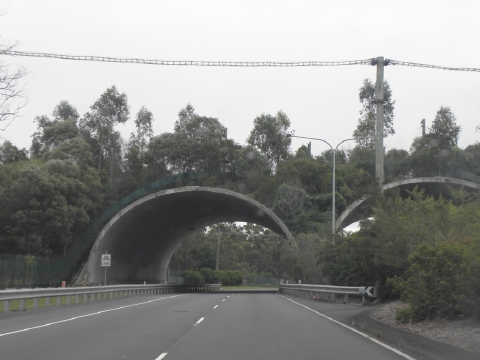 Wildlife Corridors do exist and are effective where human communities
care enough to insist on them.
But don’t expect road designers and engineers in Australia to suggest the concept. Wildlife Corridors do exist and are effective where human communities
care enough to insist on them.
But don’t expect road designers and engineers in Australia to suggest the concept.
.
.
‘Conservationists have long recognised the value of using wildlife corridors to connect wilderness areas, and there is mounting evidence to show that these corridors help many species, from the big to the small to the airborne to the aquatic.
But now ‘megacorridors’ are taking the wildlife corridor concept to a whole new level. Australia’s Great Eastern Ranges Initiative (GERI) is Australia’s answer to the megacorridor.
Aiming to create a 2800km wilderness megacorridor from North Queensland to Victoria, the initiative is about halfway towards completion of the first and most critical stage.saving-wilderness-geri-map-new-scientist.jpg
It is an extremely important move in the conservation of Australia’s biodiversity: after more than 200 years of development, the landscape of eastern Australia has changed significantly.
Fences, roads, dams, industrial and agricultural lands, powerlines, towns and cities cut across the country, isolating natural areas which have become ‘islands’ on which plants and animals have become isolated.
This means that many ecosystems have been fragmented, that the landscape’s capacity to maintain our unique plants, animals and Aboriginal cultural heritage has been reduced. It also means that remaining ecosystems are finding it harder to filter and clean our air, maintain the health of our soils, and produce unpolluted fresh water for the 93% of the Australian population that lives along Australia’s eastern seaboard.
This is no quick fix project however: climate change and the migration of human populations means it could take as long as 100 years before the project’s success can be measured.’
.
.
‘Wildlife corridor from far south to far north’
.
by Mat Churchill, 20100716, ^ http://www.tourismportdouglas.com.au/Wildlife-corridor-from-far-south-to-far.4317.0.html
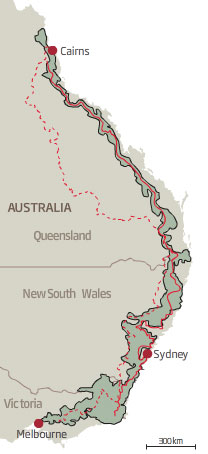
The Great Eastern Ranges Initiative, a proposed 2,800km long conservation corridor
Patches of state and national parks around the country just aren’t sufficient to protect Australia’s native plants and animals.
According to a report commissioned by the NSW Department of Environment, Climate Change and Water, a wildlife corridor 2,800km long stretching from Melbourne to the Atherton Tablelands would allow species to migrate when their habitat changes due to climate change.
”One of the impacts of climate change is that species will have to move around to find suitable habitat resources. We need to make the whole landscape more biodiversity friendly.” said Brendan Mackey, an environmental scientist who wrote the report.
Dubbed the Great Eastern Ranges Initiative, the corridor would be made up of public and privately owned land.
Ian Pulsford, from the Department of Climate Change and Water, said areas earmarked to become part of the corridor would see a person acting as a broker visit the private landholder to discuss the program.
”The corridor is voluntary but there has been a good response from private landholders, and there are incentives to make your land part of the conservation area,” said Mr Pulsford.
The corridor concept is a new way of thinking when it comes to conservation. And a change in the way we do things in Australia is clearly needed when nearly half of the world’s mammal extinctions in the last 200 years have happened here, along with 61 species of flowering plants among others. The world’s current extinction rate is 1,000 higher than nature intended.
”The conventional thinking is wait until things are really bad and then desperately try to save things at the last minute,” said Professor Mackey.
.
.
Further Reading:
.
[1] ^http://www.coolmelbourne.org/our-environment/wildlife/
.
– end of article –
Saturday, September 3rd, 2011
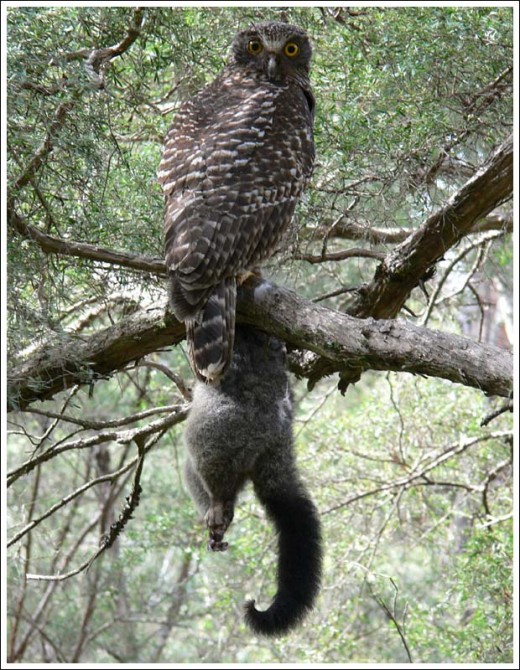 Australia’s native Powerful Owl with native prey – a juvenile Brushtail Possum (2kg?) Australia’s native Powerful Owl with native prey – a juvenile Brushtail Possum (2kg?)
© Photo by Duncan Fraser
^http://www.natureofgippsland.org/
.
Powerful Owl Call
(turn on your computer volume)

.
.
Drought, bushfires…it’ll take years to find out what’s happened to Victoria’s Forest Owls
.
[Source: ‘Something is knocking the states owls off their perches‘, by John Elder, The Age newspaper (Victoria, Australia), 20100613, ^http://www.theage.com.au/victoria/something-is-knocking-the-states-owls-off-their-perches-20100612-y4s0.html]
.
‘What’s happened to Victoria’s carnivorous owls? A significant number have vanished, and the (Victorian) Department of Sustainability and Environment (DSE) isn’t sure what’s going on.
It’s assumed the top end of the woodland food chain is either starving to death because its food source has been killed off by the drought and fires, or it is relocating to parts unknown, but it will take years to find an answer.
The DSE has been monitoring the owl populations – including that of the Powerful Owl, Australia’s largest owl – since 2000. Since then, detection rates in South Gippsland and the Bunyip State Park have dropped by half.
In some areas of the Bunyip State Park – half of which was lost to the Black Saturday fires – detections of the Sooty Owl have dropped to a third.
DSE owl specialist Ed McNabb says: ”We don’t know what’s happened to them. We can only assume that drought has played a major role. We noticed the downward trend before the fires. They’re very mobile birds, but the fires would have had an impact on their prey.”
Powerful and sooty owls, both officially listed as vulnerable, mainly eat sugar gliders and ringtail possums. The possums in particular are known to have little resistance to chronic hot weather, and their failure to thrive in the drought is the main reason why owl numbers have dropped.
While owls may have escaped (Victoria’s) Black Saturday fires, many possums would have been incinerated.
.
McNabb says the smaller carnivorous birds, such as the barking owl, are able to sustain themselves on insects. Powerful and sooty owls can also eat rabbits and birds such as magpies and kookaburras, but they need to make the change in their diet before energy loss reduces their ability to effectively hunt.
”They’ll either starve or take something else,” said McNabb.
Equally disastrous for the owls was the loss of old trees with large hollows that they require for nesting. They might have shifted elsewhere to recolonise, but this would mean taking over an already occupied territory. ”And there tends to be a home-ground advantage in these battles,” said Mr McNabb. The occupying bird has inside knowledge of the territory and a greater capacity to defend its patch, because it’s energy store will be higher. Flying great distances in search of food saps the strength from large birds and even causes them to starve.
The DSE’s biodiversity team leader for West Gippsland, Dr Rolf Willig, said:
The top order carnivores were ”an indicator species as to the well-being of the ecosystem.
Theoretically, if they’re happy, the rest are happy.”
.
For five years Dr Willig has been running a playback monitoring program in South Gippsland, where recordings of owl calls are played into the dark and answering calls are recorded. The number of birds answering calls have dropped significantly this year.
”The results indicate we may be having a delayed reaction from the fires,” he said. ”The possums not actually killed in the fires might have been exposed afterward, and the owls picked them off, eating all the food that was left.”
It will take years to find out what’s happened. ”And not just three or five years. We’ll be out here for a long time,” said Dr Willig.’
.
.
‘Conservation through Knowledge’ – a motto of leadership

The Royal Australasian Ornithologists Union is Australia’s largest non-government, non-profit, bird conservation organisation. It has sensibly branded itself as ‘Birds Australia‘, which in just two words says all that it is about, and the Emu family graphic is uniquely representative of Australia ~ the Emu being Australia’s largest bird.
Similarly sensible is its motto ‘Conservation through knowledge‘ which provides inspiration for conservation leadership, beyond Ornithology. The organisation was founded way back in 1901 to promote the study and conservation of the native bird species of Australia and adjacent regions, making it Australia’s oldest national birding association.
The Powerful Owl call above is sourced courtesy of Birds Australia.
.
.
Powerful Owl (Ninox strenua)
http://www.birdsaustralia.com.au/our-projects/powerful-owl-wbc.html
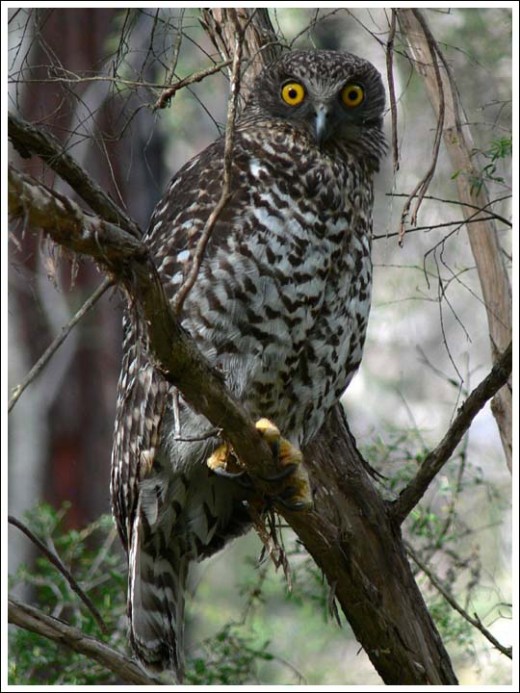 Powerful Owl (weighs under 1.5 kg) Powerful Owl (weighs under 1.5 kg)
© Photo by Duncan Fraser
^http://www.natureofgippsland.org/
.
A noctural top-order predator of tall old forests, the Powerful Owl is territorial, sedentary and monogamous ~ it calls one place home and mates for life (a lifestyle model for many humans).
.
HABITAT
Throughout most of its range this species typically inhabits open and tall wet sclerophyll forest, mainly in sheltered, densely vegetated gullies containing old-growth forest (where they breed in hollows in large trees) with a dense understorey, often near permanent streams. Such habitats are often dominated by Mountain Grey Gum, Mountain Ash, Manna Gum or Narrow-leafed Peppermint. They occasionally also occur in rainforest in gullies surrounded by sclerophyll forest or woodland. Powerful Owls also occur in adjacent open dry sclerophyll forests and woodlands, such as those dominated by box–ironbark eucalypts, Candlebark, Messmate or riparian River Red Gums; they sometimes also occur in open casuarina and cypress-pine forests.
The main food source for these owl species is hollow-dependant mammals (e.g. greater gliders, sugar gliders). Natural processes that create tree hollows typically take hundreds of years to form.
Human disturbed forests, through logging/burning/fragmentation/euphemistic ‘clearing’, destroy these vital yet rare hollow-bearing trees, and this considerably disadvantages owls.
DISTRIBUTION
- Endemic (found nowhere else on the planet, except for…) to eastern and south-eastern mainland Australia, mainly on the seaward side of the Great Divide.
.
CONSERVATION STATUS
- Vulnerable in Queensland
- Vulnerable in New South Wales
- Vulnerable in Victoria
- Endangered in South Australia
.
SURVIVAL THREATS
- Powerful Owls are adversely affected by the clearfelling of forests and the consequent conversion of those forests into open landscapes. [Deforestation]
.
When in flight, the silhouette of the Powerful Owl is distinctive, combining long, broad, rounded and deeply fingered wings with a large, sturdy body and a longish tail, gently rounded at the tip when spread. The flight is rather slow, with deep laboured wing-beats interspersed with glides.
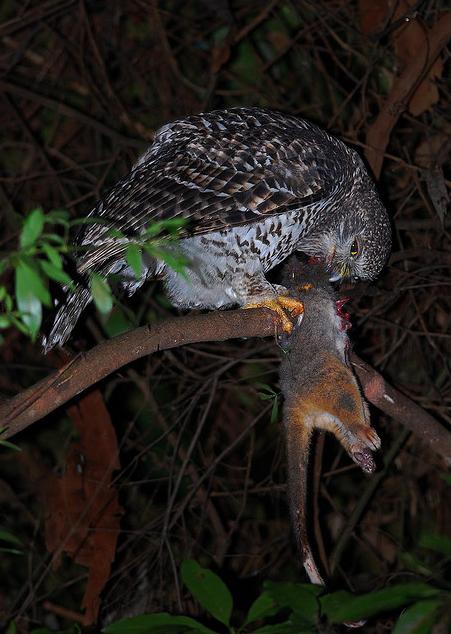
.
.
References and Further Reading:
.
[1] The Nature of Gippsland (photographic website), ‘A photo gallery featuring the natural world of Gippsland, Victoria, Australia’, Photographs by Duncan Fraser, ^ http://www.natureofgippsland.org/
[2] Birds Australia, (Special survey on Powerful Owl distribution around Sydney, 2011), ^ http://birdsinbackyards.net/surveys/powerful-owl.cfm
[3] ‘ Powerful Owl (Conservation) Action Statement, Victorian Government, Department of Sustainability and Environment, (1999), ^ http://www.dse.vic.gov.au/__data/assets/pdf_file/0019/103177/092_powerful_owl_1999.pdf [ Read More]
[4] ‘ Protecting Victoria’s Powerful Owls‘, Victorian Government, Department of Sustainability and Environment, (2001), ^ http://www.dse.vic.gov.au/__data/assets/pdf_file/0012/102144/PowerfulOwls.pdf [ Read More]
.
– end of article –
Tags: Birds Australia, Conservation through Knowledge, Forest Owls, hollow-bearing trees, old growth, Otway Ranges, Powerful Owl, Sooty Owl, South Gippsland
Posted in 07 Habitat Conservation!, Gippsland (AU), Otway Ranges (AU), Owls, Threats from Bushfire, Threats from Deforestation | No Comments »
Add this post to Del.icio.us - Digg
Friday, September 2nd, 2011
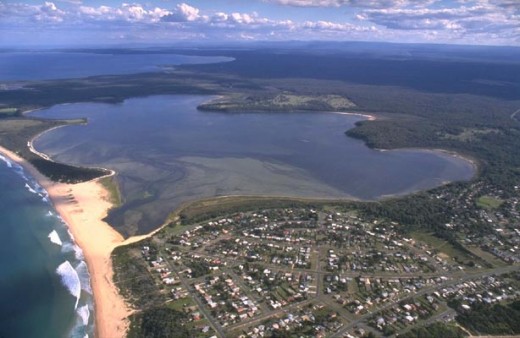 Lake Wollumboola,
South Coast (Shoalhaven Region) of New South Wales, Australia Lake Wollumboola,
South Coast (Shoalhaven Region) of New South Wales, Australia
.
Where is NSW Premier Barry O’Farrell’s environment minister when you need her?
.
Where is NSW Minister for Environment (etc.) Robyn Parker when it comes to a land use development threat to coastal breeding grounds of migratory birds and to a nominated Ramsar Wetland?
Lake Wollumboola is a natural shallow, saline, coastal lagoon, located on the NSW south coast lies north juxtaposed to Jervis Bay and forms an integral part of the Jervis Bay National Park. Lake Wollumboola is listed as a wetland of national importance, and the NSW Office of Environment and Heritage is investigating its nomination as a wetland of international importance under the Ramsar Convention on Wetlands.
Lake Wollumboola supports abundant growth of sea grass and algae, and is currently home to several thousand black swans and grey and chestnut teals and ten threatened species of Australian fauna. International migratory birds depend upon Lake Wollumboola during seasonal migration including the Caspian Tern and Little Tern.
 Little Tern (Sterna albifrons) with its distinctive black crest
[Source: ^http://www.ozanimals.com/Bird/Little-Tern/Sterna/albifrons.html] Little Tern (Sterna albifrons) with its distinctive black crest
[Source: ^http://www.ozanimals.com/Bird/Little-Tern/Sterna/albifrons.html]
.
NSW Minister for Environment etc Robyn Parker may have come to politics with the credo of ‘keeping it real’, but what environmental conservation credibility does Robyn Parker have? Many conservations are trying to keep Lake Wollumboola real and indeed free from a new golf course development threat on its northern shores.
Parker’s claim to fame is in teaching, community services, child care, childhood education, early intervention, and health issues such as drug rehabilitation and education. But sorry Adrian Piccoli MP got the Ministry for Education. So why did O’Farrell gift her with the important and controversial ‘Environment’ portfolio? No-one else put their hand up? What personal interest does Robyn Parker have in Environmental Conservation? NSW Environment Minister Robyn Parker has probably never heard of Lake Wollumboola. Has she?
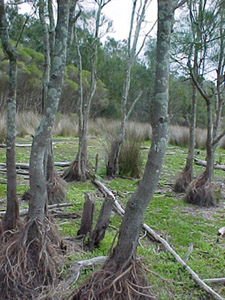
.
.
.
20th Century Golf Course Development Threat to Lake Wollumboola
.
According to the Sydney Morning Herald 20110827, defenders of Wollumboola are worried about a proposal for an 18-hole golf course on the lake’s north-western shore lodged with Shoalhaven City Council by the developer Allen, Price and Associates on behalf of the landowner, Warren Halloran. Halloran is bleating the standard ‘jobs, jobs, jobs‘ and ‘good for tourism‘ justifications for his planned development. But seriously it is just about profiting from exploitative development of natural land without a care to the ecological impact. The development concept is backward 20th Century, who the hell plays golf in the 21st Century? Golf clubs are in crisis around the nation trying to find new members. Their existing membership base of baby boomers are dying of old age!
A development application for the course lodged with the council on June 30 has attracted more than 60 submissions, nearly three-quarters opposed. Review of the proposal by local Shoalhaven Council is likely taking place behind closed doors as a ‘Confidential Business Paper‘ ~ which translates into ‘democracy exempt‘.
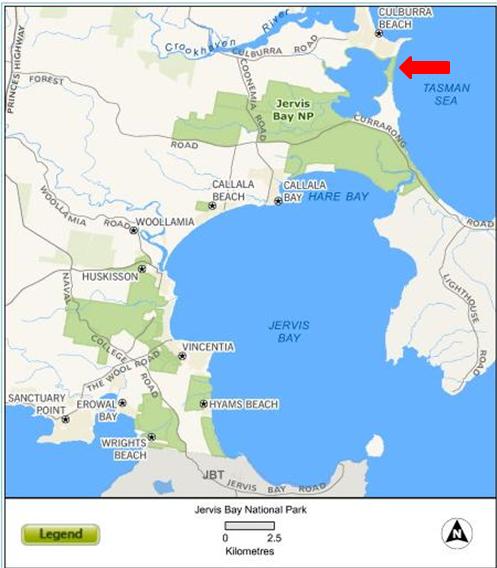
.
Council Decision on RAMSAR Wetlands?
.
The president of the Lake Wollumboola Protection Association, Frances Bray, said one of the biggest dangers from a golf course would be increased runoff of organic material and fertilisers.
It is feared that algal blooms could choke the lake, killing the fish, crustaceans and seagrass that can attract up to 20,000 birds during drought.
”It’s just the most beautiful serene place and to think that that could be degraded for a golf course is an absolute tragedy,” Ms Bray said.
A water management plan submitted with the development application proposed the construction of wetlands to treat stormwater runoff from the site, but the plan acknowledged that not all of the fairway areas would be covered.
The Greens councillor Amanda Findley, said the proposal was a last-minute attempt to develop land set down to become conservation land under proposed new land zoning.
But the proposed golf course has garnered some support from nearby Culburra Beach for employment opportunities and increased tourism.
The council will hold a public meeting on Monday.’
.
[Source: ‘Water hazard: golf plans at prized lake ruffle conservationists’ feathers’, Peter Rae, 20110827, Illawarra Mercury,^http://www.illawarramercury.com.au/news/national/national/environment/water-hazard-golf-plans-at-prized-lake-ruffle-conservationists-feathers/2272184.aspx, accessed 20110828]
 Jervis Bay Heathland near Lake Wollumboola
(© Photo by Michael Thompson) Jervis Bay Heathland near Lake Wollumboola
(© Photo by Michael Thompson)
.
.
Lake Wollumboola?
.
The Shoalhaven landscape is home to some of the outstanding natural features of the South Coast of NSW. The landscape contains wetlands of national importance, significant habitat for international migratory species, and is a habitat stronghold for the threatened Green and Golden Bell Frog.
The scenic beauty of the lower Shoalhaven and the lifestyle of coastal and estuary villages attract large numbers of visitors to the area. Important Aboriginal places around the estuary, coastal floodplain and headlands reflect a cultural attachment to the estuary’s natural resources extending over thousands of years. The Shoalhaven region includes a number of sensitive natural assets. The Shoalhaven River and estuary system, Jervis Bay, Coomondary Swamp and Lake Wollumboola and a number of other coastal lakes and estuaries all represent sensitive natural environments.
.
Lake Wollumboola
Lake Wollumboola and is a coastal estuarine lake within the Shoalhaven region situated south of Culburra Beach, between the Shoalhaven River and Jervis Bay and the Beecroft Peninsula. The Lake, sand bar and south west part of the catchment are included in the Jervis Bay National Park. It has an area catchment of 35 km2, and a waterway area of 6.2 km2. Lake Wollumboola is situated between Culburra Beach (north) and Currarong Road (south) at the northern end of the Beecroft Peninsula. Coonemia Creek flows into Lake Wollumboola. This estuary falls in the area covered by Southern Rivers Catchment Management Authority.
The lake does not possess an inlet channel – after periods of sufficient rainfall, the lake breaches directly across Warrain Beach to form the entrance.
Lake Wollumboola is recognised for its conservation attributes, and in 2002 was included in the Jervis Bay National Park. The Lake is frequented by thousands of native black swans, ducks, herons and waders, especially as a wetland refuge in times of drought. Large numbers of migratory birds visit the lake including over twenty species protected by international treaties.
‘Protected (endangered) species such as the Little Tern and Green and Golden Bell frog breed on the foreshores of the lake.’
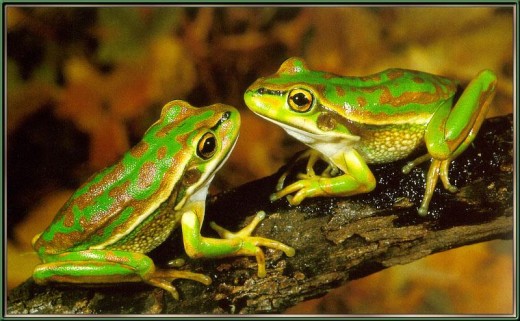
Endangered Green and Gold Bell Frogs (Litoria aurea)
.
Lake Wollumboola possesses over a square kilometre of seagrass meadows, which provide vital habitat and food sources for the many migratory bird species that seasonally visit the lake. The endangered species Wilsonia rotundifolia is also present.
The woodlands, white sands and translucent waters of Jervis Bay are reminiscent of an early, pristine environment. This park has many facets – woodland and heath, wetland and lake, seagrass beds, bays and beaches. Together they create a place that is especially beautiful. The unique Lake Wollumboola is an integral part of the park with the lake, its foreshores, associated wetlands, creeks and springs interlocking to produce twelve rich waterbird habitats in a relatively small area.
Aboriginal heritage goes back many thousands of years here and local Aboriginal people continue to maintain strong links with places special to them.
Shoalhaven City Council formed the Lake Wollumboola Estuary Management Task Force to prepare the Lake Wollumboola Estuary Management Plan.
With gazetting of the lake as part of the Jervis Bay National Park the Lake Wollumboola Reference Group was established by Department of Environment and Conservation (DEC) to oversee preparation of the Lake Wollumboola component of the Jervis Bay National Park Plan of Management.. The NSW Government is preparing a Sustainability Assessment for Lake Wollumboola, as recommended by the Healthy Rivers Commission Inquiry into Coastal Lakes.
But high human population growth rates in the Shoalhaven places considerable pressure on these natural resources, highlighting the need for appropriate management and investment.
.
Wetlands Under Threat
.
‘Wetlands are among the most threatened ecosystems in the world.
In the past, many wetlands were drained or filled in to create farmland or urban areas. In NSW, regional wetland losses range from 40% to 80% since European settlement. Although no longer openly destroyed, wetlands are currently affected by alteration of natural flow patterns caused either by droughts or by water extraction and regulation of rivers by building dams and weirs. Urban development, land clearing, grazing and use of pesticides can also impact adversely on water quality and the natural water cycles of wetlands.
Another threat to wetlands, and other ecosystems, is climate change. In inland NSW, climate change is expected to modify rainfall, evaporation and flooding patterns, increase droughts and bushfires, change the temperature of water bodies and, along the coast, cause sea levels to rise. This threat will cause the coastline to retreat and saltwater to flood freshwater lakes and lagoons.’
.
[Sources: ^ http://www.environment.nsw.gov.au/nationalparks/parkhome.aspx?id=N0090,
NSW Department of Natural Resources, ^http://test.dnr.nsw.gov.au/estuaries/inventory/wollumboola.shtml
Southern Rivers Catchment Management Authority, ^http://www.southern.cma.nsw.gov.au/our_catchment-shoalhaven.php
NSW Government Land and Property Information , Atlas of NSW – Wetlands, ^http://www.atlas.nsw.gov.au/public/nsw/home/topic/article/wetlands.html]
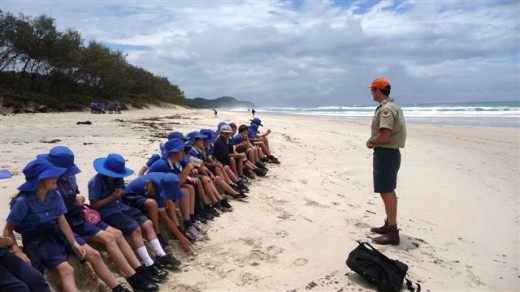
.
.
‘International recognition due to Lake Wollumboola on World Wetlands Day’
.
[Source: Nature Conservation Coucnil of NSW, 20080201, ^http://www.nccnsw.org.au/media/international-recognition-due-lake-wollumboola-world-wetlands-day]
.
The state’s peak environment group has called for the protection of Lake Wollumboola near Culburra Beach on the eve of World Wetlands Day on Saturday 2nd February.
“The Nature Conservation Council calls on the NSW Government to celebrate the unique beauty of Lake Wollumboola this World Wetlands Day and protect it under a Ramsar listing,” Cate Faehrmann, executive director of the Nature Conservation Council said today.
“Lake Wollumboola more than meets the criteria to be protected by an international Ramsar listing.
“Lake Wollumboola is a fragile and unique place that provides a safe haven for many endangered plants and animals like the Little Tern and the Green and Golden Bell Frog.
“Of the nine possible criteria for being protected under the international Ramsar listing, Lake Wollumboola meets five. Only one of these conditions needs to be met to make the area eligible for protection.
“A Ramsar listing for the lake would allow low impact recreational activities to continue, and encourage international nature and Aboriginal cultural heritage tourism and environmental education activities.
“Lake Wollumboola is one of the largest shallow saltwater lake in New South Wales. It often provides a home for thousands of iconic water birds and waders like Swans, Chestnut Teal and Bar tailed Godwits.
“The lake supports at least 43 species of migratory birds large populations of local species, with bird populations estimated at over 20,000,” Ms Faehrmann said.
.
.
During 2001/2 Researchers have been studying the complex processes of Lake Wollumboola, including the presence of Hydrogen Sulfide in the sediments and water column, and the age and rate of deposition of the sediments.
Shoalhaven City Council through its Lake Wollumboola Estuary Management Task Force developed a Community Education strategy for Culburra Beach. This focuses primarily on the Hydrogen Sulfide issue. The National Parks and Wildlife Service is likely to proceed with this program.
.
[Source: http://www.wollumboola.org.au/]
.
.
‘Lake Wollumboola gazetted as part of the Jervis Bay National Park’
.[Source: http://www.wollumboola.org.au/news.php]
.
On 11th December (1997), the Attorney General and Minister for the Environment, Mr. Bob Debus announced his decision to gazette the bed of Lake Wollumboola, the sand bar and surrounding crown land as part of the Jervis Bay National Park. Mr. Debus said the lake is one of the most significant water habitats in the State. “in recent years we have been fortunate to witness an extraordinary natural phenomena on Lake Wollumboola when 20,000 waterbirds at a time gather to feed on the lake’s rich food source.”.
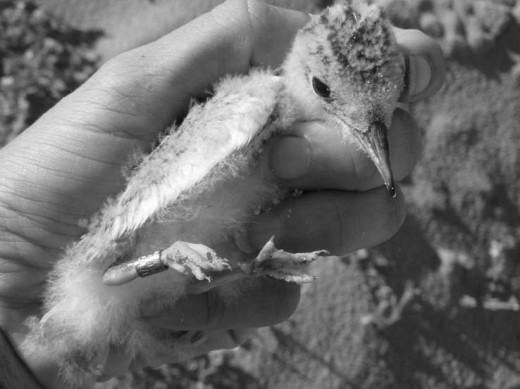 Little Tern chicks at Lake Wollumboola, 2008
(click photo to enlarge) Little Tern chicks at Lake Wollumboola, 2008
(click photo to enlarge)
.
.
.
‘The saviours of Lake Wollumboola’
[Source: Penny Figgis (ACF Vice President and a board member of the Environment Protection Authority of NSW) and Bruce Donald (Sydney lawyer and consultant, and gave voluntary legal advice to the campaign).
© 2000 Australian Conservation Foundation, © 2008 Gale, Cengage Learning, ^http://findarticles.com/p/articles/mi_hb4727/is_4_28/ai_n28789147/
.
In 2008, local conservationists, Frances Bray and Keith Campbell, were celebrated as winners of the Australian Conservation Foundation’s Peter Rawlinson Conservation Award.
‘For more than seven years Frances and Keith, together with many dedicated people in the Lake Wollumboola Support Group, tirelessly fought against a huge subdivision of some 3000 houses that would have unquestionably damaged the unique ecology of the lake and its surrounding forest.
Lake Wollumboola is one of the New South Wales coastline’s last remaining, virtually pristine, coastal lakes that intermittently open and close to the sea. It lies at Culburra Beach between the mouth of the Shoalhaven River and Jervis Bay. The lake is on the Register of the National Estate, is a wetland of key significance and a habitat for resident and migratory birds of international importance. Several threatened species have been identified within the area, including the green and gold bell frog which is seasonally abundant in the grassy edges of the lake.
For most of the past century the land around the lake was within the paper subdivision plans of the only major developer of the Shoalhaven, Realty Realizations. In the early 1990s the company finally achieved a rezoning of the land by the Shoalhaven City Council and the government of the day. The subdivision carried with it the threat of serious pollution from urban run-off, loss of forested habitat and increased recreational pressures, including demands to prevent the lake’s natural cycle of periodic draining.’
.
In for the long haul
‘Although the politics and regional power dynamics were against them and government departments were equivocating, Frances Bray and Keith Campbell refused to consider the battle lost. Together with the Lake Wollumboola Support Group, they mobilised all the effort needed to begin the task. Their dogged campaign finally achieved a decision in 1995 by the Minister for Urban Affairs and Planning to remove from the council its ability to approve the subdivision. Then, in 1996, a Commission of Inquiry into the subdivision was appointed.
At this point Frances and Keith enlisted some voluntary legal back-up and achieved a historic grant of legal aid for the inquiry from the New South Wales Legal Aid Commission. Though small, this grant helped obtain high calibre water, fauna, vegetation and social impact reports from acknowledged experts to give independent substance to their case. This also contributed to a reversal by National Parks and Wildlife Service on the first day of the inquiry of its previous decision that a Faunal Impact Statement was not necessary. Gradually over the extended four years of the inquiry the support of the principal regulatory agencies gathered force.
All of this, however, was achieved against strident support for the development at the local level. Local media targeted Frances, Keith and their colleagues with all the familiar distressing and defamatory charges that make this sort of campaign emotionally exhausting for those in the front line. These attacks continued over the duration of the inquiry and, with the enormous demands of preparing submissions of a high quality and responding to the voluminous information advanced by the developer, lesser campaigners would have been knocked out of the race. Yet they completed an outstanding and detailed submission, now held by the Environmental Defenders Office (NSW) as the leading precedent for pro-environment representation.’
.
Inspiration for us all
‘The tireless and exhausting efforts by these two remarkable campaigners and their colleagues was rewarded when on 5 April 2000 the Commission of Inquiry ruled for the environment and against the development, adopting nearly all of Frances and Keith’s submissions.
Then on Friday 2 June, just a few days before ACF announced its award, Deputy Premier and Planning Minister, Dr Andrew Refshauge, announced the government’s decision to refuse the proposed residential subdivision within the catchment of the lake.
The ACF Peter Rawlinson Conservation Award presents a fitting opportunity for a more public recognition of these brave and passionate people who were not prepared to stand and watch the loss of a place of such enormous value. They are fitting winners of the environment movement’s highest accolade.’
.
‘Turning Point for Lake Wollumboola’
[Source: Frances Bray, (2000), NPA supporter and Convenor of the Lake Wollumboola Support Group, ^http://dazed.org/npa/npj/200012/Deccover.htm]
.
This has been an extraordinary year for coastal protection generally, and for Lake Wollumboola in particular. The Premier, the Hon Bob Carr, outlined new policy directions. The NSW Government announced in April that the catchments of five South Coast lakes would be protected as national parks. It then requested the Healthy Rivers Commission to conduct an inquiry into the protection and management of coastal lakes. The Coastal Lakes Inquiry issues paper brought further good news, with its proposals for Lake Wollumboola and eight other South Coast lakes to be protected as reserves and considered for World Heritage listing.
Then on 2nd June the Deputy Premier and Minister for Urban Affairs and Planning, Dr Andrew Refshauge, announced his decision to refuse the Long Bow Point subdivision application, at Culburra Beach near Nowra on the South Coast. The proposal involved development of 837 housing lots, stage 1 of a 3,000 lot development, mainly in the catchment of Lake Wollumboola (see also June NPJ). He said,
“The evidence is overwhelming – our primary concern must be the long-term protection of the Lake.”
Members of the Lake Wollumboola Support Group are overjoyed by the Minister’s adoption of our case. The group has been campaigning, since 1993, to stop the development because of its likely destructive impacts on the unique ecology of this most fragile of coastal lakes and its catchment.
Our group was formed in response to Shoalhaven City Council seeking comment at the commencement of the Estuary Management Study for Lake Wollumboola. Soon after, we learned of plans by Realty Realisations, a landowner and developer, for a massive development primarily in the catchment of the lake. We decided to work to protect the lake, and to inform the Culburra Beach community on related issues.
.
A unique ecology
Lake Wollumboola is located just north of Jervis Bay. Maps and records from 1805, when the first Europeans came to the area, confirm that Lake Wollumboola was much the same then as it is today and that the area provided a rich environment for Aboriginal people. The Jerringa people maintain today their traditional cultural ties with Lake Wollumboola and the Beecroft Peninsula.
Lake Wollumboola is an intermittently closing and opening lake. It is particularly vulnerable to urban pollution and disturbance because it is shallow, above mean sea level and is infrequently open to the sea, causing high nutrient levels to build up in the sediments. Additional pollution is likely to maintain permanently eutrophic conditions, with algal blooms, death of seagrass and ultimately decline of the lake’s extraordinarily rich ecology.
Inter-glacial wave-cut reefs and rock platforms form much of the lake bed. The lake’s catchment is coastal bushland, wetland and heath of significant biodiversity, with at least 300 species each of flora and fauna at Long Bow Point, and at least 33 threatened species in the immediate catchment. Green and golden bell frogs are reasonably abundant around its shore, as well as the extremely rare wetland plant Wilsonia rotundifolia.
The lake is listed on the Register of the National Estate, in the Directory of Wetlands of national significance, and meets the criteria for listing under the Ramsar Convention as a wetland of international significance for water birds.
Lake Wollumboola is recognised and protected under migratory bird agreements with China and Japan as internationally significant habitat. At least 43 species of migratory birds, including little terns, have been identified, as well as large populations of local species such as black swan, teal and royal spoonbill. In the summer of 1999 a spectacular bird event occurred, with populations in excess of 20,000 and high bird populations are continuing.
.
Long-standing conflict
Conflict between protection of the natural environment of the Jervis Bay region and inappropriate development is long-standing. Since the early 1900s, Realty Realisations (the principal landowner in the region) has floated various plans to develop paper subdivisions in environmentally sensitive areas. There is equally a long history of efforts to protect this unique area. Myles Dunphy in the 1940s and NPA in 1974 put forward proposals to Government to protect the lake and the Beecroft Peninsula to its south.
The NPA case for national park status, as quoted by Alan Catford in the National Parks Journal, August 1974, says, “The club-shaped Beecroft Peninsula, which backs Point Perpendicular, the northern part of Jervis Bay, combined with the magnificent lagoon of Lake Wollumboola and the connecting lowland, is an ideal national park. Variety is surely its keynote.”
Realty Realisations and Shoalhaven City Council had other ideas. In 1992 the north-west area of the catchment was rezoned to residential as the Culburra Urban Expansion Area, by agreement between Realty Realisations, the Council and the NSW Government.
In 1995, Shoalhaven City Council was poised to approve the Long Bow Point Subdivision application, despite our protests and the reservations of several government agencies. Following the election of the Labor Government, the then Minister for Urban Affairs and Planning, Craig Knowles, in August 1995 called in the Long Bow Point subdivision and subsequently agreed to establish a Commission of Inquiry (COI).
In October 1996, Commissioner Carleton convened the first session of the Long Bow Point Subdivision COI. The Lake Wollumboola Support Group, the Culburra Beach Progress Association and, finally, the government agencies, opposed the subdivision. The NPWS reversed its previous position and advised that a Fauna Impact Statement (FIS) would be required. At the resumption of the Inquiry in November 1996, the Commissioner adjourned it indefinitely at the request of the developer, to allow for completion of a FIS.
The following three years of waiting were very stressful. In March 1998 we suffered a major setback with the release of the NPWS’ Assessment of the Natural Heritage Values of the Culburra Urban Expansion Area and Environs. While this report recommended consideration of national park or marine park status for Lake Wollumboola and recognised the high conservation values of much of the proposed development site, it recommended to the Minister for the Environment that the Government not purchase Long Bow Point. The Minister, Pam Allen, accepted this recommendation, to our great disappointment. Nevertheless, the Government purchased a large area of land between Jervis Bay and the southern shore of the lake, which is now part of Jervis Bay NP.
In November 1999, the COI reconvened, with the final hearing in January this year. In April, the COI report was released, recommending refusal of the subdivision because of its likely impact on Lake Wollumboola and its catchment. On 2 June, Dr Refshauge announced his decision to refuse the subdivision and to establish a review of planning controls and environmental management for the catchment.
.
Techniques for success
The success of our part in this landmark decision was due to several factors.
We studied and recorded the behaviour of Lake Wollumboola, analysed and interpreted research and expert advice. With the assistance of a Legal Aid Commission grant, we obtained advice from a highly professional group of experts who supported us in our submissions and presentations. Their original data and research covered water quality; evaluation of water-pollution control measures; ecology of the lake and its catchment, particularly its extraordinary birdlife; environmental law; and social and economic impacts of the proposed development.
We also worked closely with environment groups who gave us expert and strategic support, in particular Total Environment Centre, NPA, Nature Conservation Council, the Australian Conservation Foundation (ACF) and our local coalition of environment and community groups, the Jervis Bay Regional Alliance.
On World Environment Day, a few days after Minister Refshauge’s announcement, ACF recognised our efforts by awarding Frances Bray and Keith Campbell the Peter Rawlinson Conservation Award. This prestigious award focuses national attention on the lake and will assist us greatly in our ongoing campaign: to have Lake Wollumboola and its catchment protected from urban development for all time.
We are delighted also that the Lake Wollumboola Support Group has received local recognition. Narelle Wright, Frances Bray and Keith Campbell were honoured with Shoalhaven Healthy Cities awards, for their efforts to protect the lake.
Whilst the refusal of the Long Bow Point subdivision provides breathing space, the future of protection of Lake Wollumboola is not yet guaranteed. We hope this year represents the turning point, with the Healthy Rivers Commission Coastal Lakes Inquiry issues paper adding further weight to the Lake Wollumboola cause.
We hope other local environment groups will take heart from our success so far and join us in supporting these significant proposals.
.
References
-
- The Hon Bob Carr. Speech to the Brisbane Institute, A Matter of National Importance – Protection of the Australian Coastline. April 2000
- Healthy Rivers Commission. Independent Inquiry into Coastal Lakes – Issues Paper. October 2000
- Ministerial media release, 2 June 2000
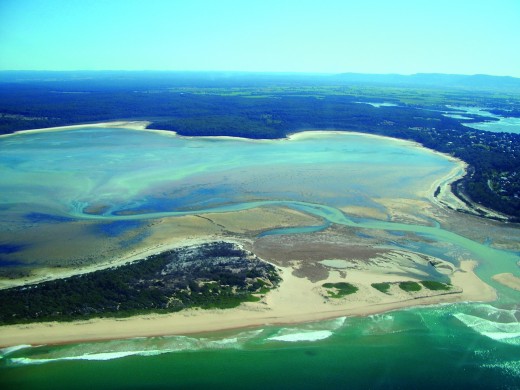 Lake Wollumboola – nominated RAMSAR wetland
(click photo to enlarge, then click to enlarge again!) Lake Wollumboola – nominated RAMSAR wetland
(click photo to enlarge, then click to enlarge again!)
.
.
History of Estuary and Catchment Use and Abuse
.
[Source: ‘Coastal Management in Australia – Key institutional and governance issues for coastal natural resource management and planning‘, (2006), published by the CRC for Coastal Zone, Estuary and Waterway Management, and supported by The Australian National University and the National Sea Change Taskforce, ^http://www.griffith.edu.au/__data/assets/pdf_file/0006/313359/Coastal_Management_in_Australia.pdf [Read More]
.
‘Critical to human health and the biological health of coastal waterways are factors influencing the discharge of waters, sediments, nutrients and pathogens into rivers and estuaries.
Throughout the 19th and 20th centuries, land clearance, soil erosion and urbanisation (including canal estates) have all contributed to the cumulative degradation of rivers, estuaries and coastal lakes.
Symptoms of the degradation are many including:
- Siltation of channels, which in some cases like on the Hunter has resulted in downstream displacement of shipping ports, and in the burial of estuarine sea grasses;
- Increased levels of nutrients, especially nitrogen and phosphorus, which are key elements for plankton and plant growth and trigger algal blooms when they reach excessive levels; and
- The presence of pathogens which may be digested by humans causing death and ill-health following consumption of seafood, or ingested while swimming.
.
Quite clearly urbanisation and deforestation has had some effect along the east coast.
The saga of Wallis Lake since the oyster contamination event of 1997 is there to remind us of the sensitivities of waters to pollutants. These sensitivities are not just biophysical and economic, but also lead to complex judicial proceedings on responsibilities under the common law concept of ‘duty of care’ as determined in the Wallis Lake case by the High Court.
We know that increasing nutrient loads or even the sediment loads from catchments into estuarine and lake systems may not trigger much change as these systems have considerable resilience to varying biophysical conditions. However, the fear is always that a lake/lagoon or estuary backwater will go beyond the ‘critical load point’. Turbidity and phytoplankton will then dominate.
It was such a concern that encouraged the then Planning Minister for NSW, Andrew Refshauge, in 2001, to stop a 2000-lot subdivision at Lake Wollumboola on the NSW south coast. This was at a location which years before had been zoned for such intensive urban use.’
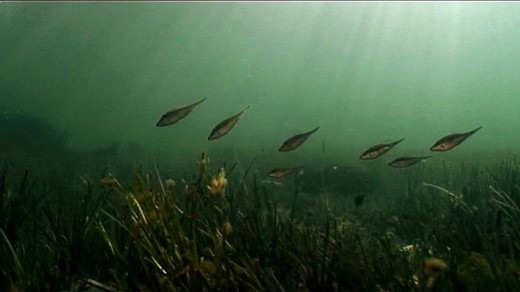
Seagrass Meadow
Source: ^http://www.hn.cma.nsw.gov.au/
..
‘Lake Wollumboola- Listing as a Ramsar site’
[Source: Amanda Findley, Shoalhaven Greens blogsite, 20110628, ^http://amandashoalhavengreens.blogspot.com/2011/06/lake-wollumboola-listing-as-ramsar-site.html]
 Black Swans and Teal (left) on Lake Wollumboola
© Photo by Frances Bray
(click photo to enlarge, then click to enlarge again! ~ you’re being looked at.) Black Swans and Teal (left) on Lake Wollumboola
© Photo by Frances Bray
(click photo to enlarge, then click to enlarge again! ~ you’re being looked at.)
.
.
‘Shoalhaven Council is it so narrow minded that it will not support taking a step forward in listing a lovely wetland in the RAMSAR register? seems so.
Department of Environment and Heritage have approached Council to advise that they wish to begin the process of talking to the community about listing this special little lake as a significant wetland- local campaigner Frances Bray sent the following letter to Council to try and influence tonights decision making.
Thanks Frances for allowing me to share this and your great photo of the swans and teals.’
~ Amanda Findley.
————————–
‘To General Manager and Shoalhaven City Councillors,
Please circulate this message to all Councillors,
I understand that at your meeting on Tuesday next, that you will consider a recommendation to oppose the listing of Lake Wollumboola as a Wetland of International importance under the Ramsar Convention.
Today I have been on a bird counting walk at Lake Wollumboola with ornithologist, Ms Joy Pegler. The Lake is an astonishing site, with Joy counting 1100 Black Swan, 957 Grey Teal and 536 Chestnut Teal, as well as 9 other species.
Here is a photo of some of the birds which are easily viewed from the north shore. Do come and enjoy this wonderful experience.
I urge you to think carefully about the benefits of Ramsar listing. Increased monitoring and research into this unique Lake would benefit its management, whilst maintaining current recreational activities. There would be significant benefits for the Aboriginal community from employment in management and Cultural tourism opportunities if community members choose to support Ramsar listing. The local and wider Shoalhaven community would benefit too from carefully promoted and managed national as well as international tourism.
The Lake Wollumboola Protection Association Inc as well as many Culburra Beach residents and ratepayers strongly support Ramsar listing, knowing the special qualities of the Lake especially for birds and understanding that Lake Wollumboola meets the relevant Ramsar criteria.
We understand that the NSW Office of Environment and Heritage is in the process of consulting the Aboriginal community regarding its views and we respect the need for that consultation to continue before the Office proceeds with consultation with the wider community.
Please do not jeopardise the planned consultations and the opportunities represented by Ramsar listing.’
Yours faithfully,
Frances Bray.
President Lake Wollumboola Protection Association Inc
.
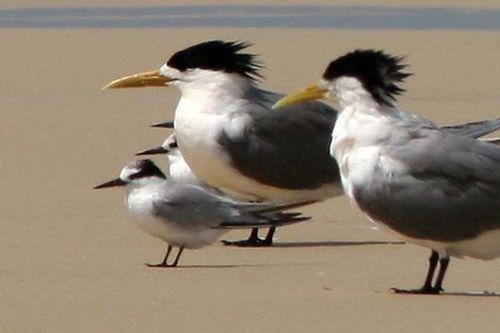 Little Terns Little Terns
.
.
Footnote
.
Ramsar Convention on Wetlands
.
The Convention on Wetlands of International Importance, called the Ramsar Convention, is an intergovernmental treaty that provides the framework for national action and international cooperation for the conservation and wise use of wetlands and their resources. The Ramsar Convention is the only global environmental treaty that deals with a particular ecosystem. The treaty was adopted in the Iranian city of Ramsar in 1971 and the Convention’s member countries cover all geographic regions of the planet.
The Convention on Wetlands is an intergovernmental treaty whose mission is “the conservation and wise use of all wetlands through local, regional and national actions and international cooperation, as a contribution towards achieving sustainable development throughout the world”. As of October 2010, 160 nations have joined the Convention as Contracting Parties, and more than 1900 wetlands around the world, covering over 186 million hectares, have been designated for inclusion in the Ramsar List of Wetlands of International Importance.’
The Ramsar Mission
‘The Convention’s mission is “the conservation and wise use of all wetlands through local and national actions and international cooperation, as a contribution towards achieving sustainable development throughout the world”.
The Convention uses a broad definition of the types of wetlands covered in its mission, including lakes and rivers, swamps and marshes, wet grasslands and peatlands, oases, estuaries, deltas and tidal flats, near-shore marine areas, mangroves and coral reefs, and human-made sites such as fish ponds, rice paddies, reservoirs, and salt pans.’
.
What are wetlands?
.
‘As defined by the Convention, wetlands include a wide variety of habitats such as marshes, peatlands, floodplains, rivers and lakes, and coastal areas such as saltmarshes, mangroves, and seagrass beds, but also coral reefs and other marine areas no deeper than six metres at low tide, as well as human-made wetlands such as waste-water treatment ponds and reservoirs.’
The Wise Use Concept
.
‘At the centre of the Ramsar philosophy is the “wise use” concept. The wise use of wetlands is defined as “the maintenance of their ecological character, achieved through the implementation of ecosystem approaches, within the context of sustainable development”. “Wise use” therefore has at its heart the conservation and sustainable use of wetlands and their resources, for the benefit of humankind*.’
.
[Source: ^http://www.ramsar.org]
.
*Editor: “for the benefit of humankind‘? Why so anthropocentric? It is not as if humankind has not benefited itself since it could at the expense of other species.
A more appropriate ending phrase would be:… “out of respect for the ecological rights of wetland-dependent species and ecological communities for survival, health and natural life processes, undisturbed”.
.
Further Reading:
.
[1] Lake Wollumboola Protection Association Inc. ^ http://www.wollumboola.org.au/
[2] ‘ Management of Amphibian Populations in Booderee National Park, South-Eastern Australia‘ (2010), by Trent D. Penman (University of Wollongong) and Traecey Brassil (NSW Department of Primary Industries) [ Read More]
[3] ‘Giving Little Terns Their Best Chance of Survival – Lake Wollumboola Little Tern Conservation Program’, (2008), by Frances Bray, ^ http://www.coastalconference.com/2008/papers2008/Bray,%20Frances%20Session%205A.pdf
[4] ‘ South Coast Shorebird Recovery Programme (2008/09 Breeding Season)’, ^ http://www.southcoastshorebirds.com.au/shorebird_downloads/annual_report/Shorebird%20Report%20200809final.pdf
[5] ‘Illawarra Bird Observers Club, Inc.’, ^ http://www.iboc.org.au/info/IBOCNewsMay2010.pdf
[6] R.J. Williams, G. West, D. Morrison and R.G. Creese, (2006), ‘ Estuarine Resources of New South Wales’, prepared for the Comprehensive Coastal Assessment (DoP) by the NSW Department of Primary Industries, Port Stephens.
[7] R.J. West, C.A. Thorogood, T.R. Walford and R.J. Williams. (1985), ‘ An Estuarine Inventory for New South Wales, Australia‘, Fisheries Bulletin 2. Department of Agriculture, New South Wales.
[8] ‘Wise Use of Wetlands‘ (Handbook 1), RAMSAR Convention on Wetlands,^ http://www.ramsar.org/pdf/lib/hbk4-01.pdf [ Read More]
.
– end of article –
Estuary and catchment use and abuse
Critical to human health and the biological health of coastal waterways are factors
influencing the discharge of waters, sediments, nutrients and pathogens into rivers and
estuaries. Throughout the 19th and 20th centuries, land clearance, soil erosion and
urbanisation (including canal estates) have all contributed to the cumulative
degradation of rivers, estuaries and coastal lakes. Symptoms of the degradation are
many including:
• siltation of channels, which in some cases like on the Hunter has resulted in
downstream displacement of shipping ports, and in the burial of estuarine sea
grasses;
• increased levels of nutrients, especially nitrogen and phosphorus, which are key
elements for plankton and plant growth and trigger algal blooms when they reach
excessive levels; and
• the presence of pathogens which may be digested by humans causing death and
ill-health following consumption of seafood, or ingested while swimming.
Quite clearly urbanisation and deforestation has had some effect along the east coast.
The saga of Wallis Lake since the oyster contamination event of 1997 is there to
remind us of the sensitivities of waters to pollutants. These sensitivities are not just
biophysical and economic, but also lead to complex judicial proceedings on
responsibilities under the common law concept of ‘duty of care’ as determined in the
Wallis Lake case by the High Court.
We know that increasing nutrient loads or even the sediment loads from catchments
into estuarine and lake systems may not trigger much change as these systems have
considerable resilience to varying biophysical conditions. However, the fear is always
that a lake/lagoon or estuary backwater will go beyond the ‘critical load point’. Turbidity
and phytoplankton will then dominate. It was such a concern that encouraged the then
Planning Minister for NSW, Andrew Refshauge, in 2001, to stop a 2000-lot subdivision
at Lake Wollumboola on the NSW south coast. This was at a location which years
before had been zoned for such intensive urban use.
Tags: Allen Price and Associates, Beecroft Peninsula, Birds (Migratory), Caspian Tern, Culburra Beach, golf course development, Jervis Bay National Park, keeping it real, Lake Wollumboola, Lake Wollumboola Protection Association, Little Tern, Ramsar Convention on Wetlands, Ramsar Wetlands, Shoalhaven, Shoalhaven Council, Southern Rivers Catchment Management Authority
Posted in 07 Habitat Conservation!, Birds (Migratory), Threats from Development | No Comments »
Add this post to Del.icio.us - Digg
Monday, August 29th, 2011
[The following article was initially published by Tigerquoll on CandoBetter.net on 20090730 under title ‘African Elephants – still slaughtered for tusk (‘ivory’) trinkets by backward Japanese and Chinese‘, with some modifications]
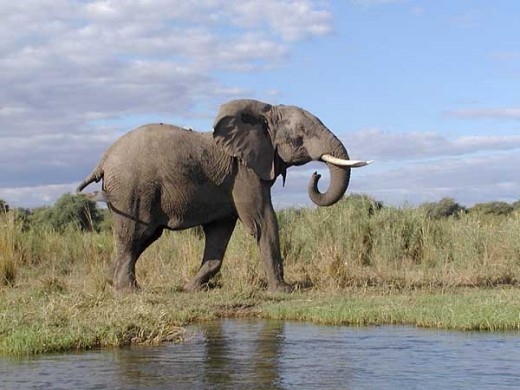 The magnificent African Bush Elephant bull (male) walking tall in its native savannah homeland
The magnificent African Bush Elephant bull (male) walking tall in its native savannah homeland
.
Out of Victorian colonial exploits of the 19th Century, elephant tusks could be found butchered and refined into expensive goods, notably billiard balls, piano keys, Scottish bagpipes, garment buttons, letter openers and for many ornamental items otherwise considered mere ‘trinkets’.
After the elephant tusk (‘ivory’) trade had decimated the African Elephant population from 1.3 million to 625,000, finally in 1989 the Environmental Investigation Agency (EIA) imposed a ban on this international elephant tusk (ivory) trade.
Ten years on, Zimbabwean dictator, Robert Mugabe, lifted the ban along with Botswana, Namibia, and South Africa and legalised the sale of elephant tusks from elephants they claimed (a) had died naturally or (b) been shot because they were violently aggressive or for ‘problem-animal’ control. In 1999, the Convention on International Trade in Endangered Species of Wild Fauna and Flora (CITES) authorized an auction of 50 tons of elephant tusks (ivory) from these four countries to the value of USD$5 million. Notably, the demand for elephant has been driven outside the African continent, in this episode mainly by Japan.
One could find a comparable solution for controlling Robert Mugabe…
 Tool of the Willing
(for just one day hire, …’our troubles there would be over very quickly’.)
~ borrowed from Colonel Walter E. Kurtz. Tool of the Willing
(for just one day hire, …’our troubles there would be over very quickly’.)
~ borrowed from Colonel Walter E. Kurtz.
.
In 2008, China was also given permission to become a licensed buyer of elephant tusks (ivory) and this followed 108 tons of elephant tusks (ivory) being auctioned from these same four African countries, representing the death of over 10,000 African elephants.
.
“The growing demand for elephant tusks (ivory) has increased black market prices from $200 per kilo to $850 per kilo in the past four years thus creating a big financial incentive for poachers. Michael Wamithi, program director for International Fund for Animal Welfare’s global elephants program, and former director of the Kenya Wildlife Service, declared: “An estimated 20,000 elephants are slaughtered annually for the trade in their tusks. Many African elephant range states clearly do not have the capacity or resources to combat these massive attacks on their countries’ wildlife heritage and the burgeoning markets in China are only fuelling these attacks.”
.
The Environmental Investigation Agency (EIA), which exposes environmental crimes, said CITES had ignored appeals from other African nations not to increase pressures on their elephant populations which were already struggling with wars, instability, droughts and poverty. EIA chairman Allan Thornton said:
“Responsibility for the poaching of 20,000 elephants in Africa each year will now lie with those who supported China obtaining legal ivory trade even though they continue to be the world’s biggest destination for poached ivory.”
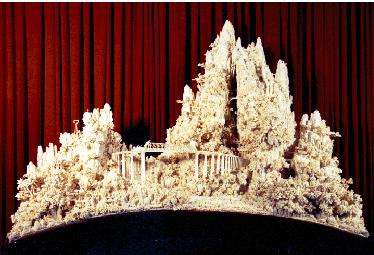 This elephant tusk (ivory) carving (photo) is a gift from China presented to the United Nations in 1974.
It depicts the Chengtu-Kunming railway, which was opened to traffic in 1970.
The sculpture was carved from eight elephant tusks. In elephant terms, four mature bull elephants were killed for this elaborate trinket. This elephant tusk (ivory) carving (photo) is a gift from China presented to the United Nations in 1974.
It depicts the Chengtu-Kunming railway, which was opened to traffic in 1970.
The sculpture was carved from eight elephant tusks. In elephant terms, four mature bull elephants were killed for this elaborate trinket.
One wonders whether the United Nations is still pleased with its eight bull elephant tusk trophy (shot and hacked off from a bull elephant like that above)?
.
.
Chinese, Japanese and Thais still Elephant Poaching in Africa
.
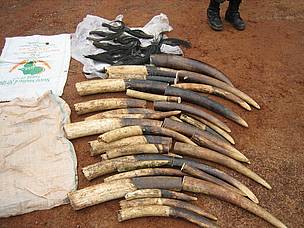
China and Japan bought 108 tonnes of ivory in another “one-off” sale in November 2008 from Botswana, South Africa, Namibia and Zimbabwe. At the time the idea was that these legal ivory sales may depress the price, thereby removing poaching pressure, an idea supported by both Traffic and WWF.
China’s increased involvement in infrastructure projects in Africa and the purchase of natural resources has alarmed many conservationists who fear the extraction of wildlife body parts is increasing. Since China was given “approved buyer” status by CITES, the smuggling of ivory seems to have increased alarmingly. Although, WWF and Traffic who supported the China sale, describe the increase in illegal ivory trade a possible “coincidence” others are less cautious. Chinese nationals working in Africa have been caught smuggling ivory in many African countries, with at least ten arrested at Kenyan airports in 2009. In many African countries domestic markets have grown, providing easy access to ivory, although the Asian ivory syndicates are most destructive buying and shipping tonnes at a time.
Contrary to the advice of CITES that prices may be depressed, and those that supported the sale of stockpiles in 2008, the price of ivory in China has greatly increased. Some believe this may be due to deliberate price fixing by those who bought the stockpile, echoing the warnings from the Japan Wildlife Conservation Society on price-fixing after sales to Japan in 1997, and monopoly given to traders who bought stockpiles from Burundi and Singapore in the 1980s. It may also be due to the exploding number of Chinese able to purchase luxury goods.
Despite arguments prevailing on the ivory trade for the last thirty years through CITES, there is one fact that virtually all informed parties now agree upon: poaching of African elephants is now seriously on the increase.’
.
.
‘Shopping habits of China’s ‘suddenly wealthy’
[Source: by Rose Gamble, freelance journalist, FT.com, 20090821, ^http://www.ft.com/cms/s/2/9271a266-8d21-11de-a540-00144feabdc0.html#ixzz1WPkaKde6, accessed 20110829]
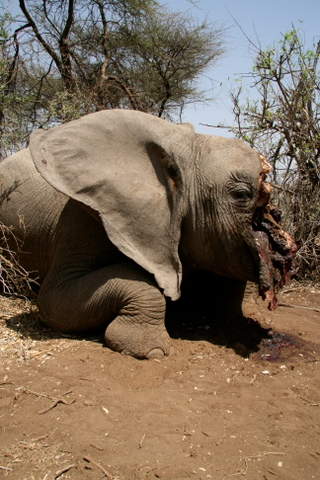
.
Ivory:
‘For more than 7,000 years, Chinese artisans have been crafting elephant ivory. Favoured by the Imperial household as far back as the Qing dynasty (1680), ivory has an illustrious reputation and an association with the wealthy and elite. But in 1989, the trading of ivory was banned worldwide through the Convention on International Trade in Endangered Species (Cites), after more than half of Africa’s 1.3 million elephants were poached in a single decade. And yet, with a carving trade established in antiquity and a burgeoning middle class who, for the first time, can afford to buy ivory, China remains its biggest importer.
As Asian elephant herds dwindle, African elephants have become the only source of ivory.
In late 2008, Cites authorities allowed China to bid with Japan for tusks from official stockpiles – consisting of ivory collected from elephants that had died a natural death – in four southern African countries. In an open declaration of a continuing demand, 12 Chinese traders bought 62 tonnes at an average price of $144 per kilo. Since this legal purchase, more than 11 tonnes of illegal African ivory have been impounded en route to China.
Elephant poaching largely takes place in central Africa, where poverty and political instability are rife. Chronic unemployment, the availability of firearms and corruption all facilitate the illegal ivory trade. These regions are also home to unregulated domestic ivory markets, where carved items are bought and sold. According to ivory expert Esmond Martin, the majority of buyers are Chinese. In a scramble for Africa’s minerals and resources, the continent has seen a recent influx of Chinese workers – a presence that is visibly reflected in the illegal retailing of ivory. On a recent trip to Addis Ababa, Ethiopia, Martin recorded 1,433 items of ivory openly displayed in the city’s main streets and central market. Among these were 149 pairs of freshly carved ivory chopsticks, selling for $16 each – in sharp contrast to a Chinese retail price of $139 – and signature stamps and jewellery. All of these items were small enough to potentially smuggle through customs.
Martin had previously estimated that 4,900 to 12,000 elephants from central Africa were killed each year to supply tusks to the craftsmen of Africa, China and Thailand.
Conservationists are deeply concerned. According to Barbara Maas, CEO of Care for the Wild International: “With the number of Chinese nationals resident in Africa rising, and poaching on the increase, the frontline between supply and demand for ivory is now perilously close, with a disastrous outcome for elephants.”
.
..
‘Campaigners’ fear for elephants, and their own credibility’
[Source: The Economist, 20080717, ^http://www.economist.com/node/11751304 ]
.
‘Nobody can deny that China’s black market was rampant until recently. In a report to the UN leaked by the Environmental Investigation Agency (EIA), a campaigning group, this month, Chinese officials admitted that between 1991 and 2002 they had lost sight of 121 tonnes of ivory, the equivalent of the tusks from 11,000 elephants.
Is China observing the CITES rules now? A brief visit to China in 2007 by inspectors from the CITES secretariat suggested that things had improved: they said that ivory was becoming harder to find, though they came across a shop in the city of Xi’an with ivory carvings of dubious provenance. A bigger investigation was carried out by TRAFFIC, an independent British-based group that monitors wildlife trade. After studying 10,000 shops between 2006 and 2008, it reported a progressive decline in the availability of illegal ivory. This had coincided with greater police vigilance.
The idea that China is cleaning up its act got another boost in March, when over 750kg (1,650lb) of raw ivory was seized in Guangxi Province. As CITES notes, the penalties for illegal trading include life imprisonment and death. But the EIA, which uses undercover methods to probe the trade, says things are not as good as they seem; in 2007 its researchers found a roomful of illegal ivory, including an uncut tusk, for sale in the city of Dalian. Last month they made a small find in Gansu province.
A more interesting question is how the legal sales now in prospect will affect the black market. A fresh supply of legal ivory may depress the price, and reduce the incentive to poach. TRAFFIC notes that after a legal auction in 1999, the price fell; this led to a decline in poaching over five years. For doctrinaire types, who oppose all trade in ivory, the forthcoming sale is not just a challenge to endangered animals; it could be a threat to the credibility of their best-loved arguments.’
.
.
‘Data shows illegal ivory trade on rise’
[Source: World Wildlife Fund (WWF), Cambridge, UK, 20091116, ^http://wwf.panda.org/wwf_news/?uNewsID=180702, accessed 20110829]
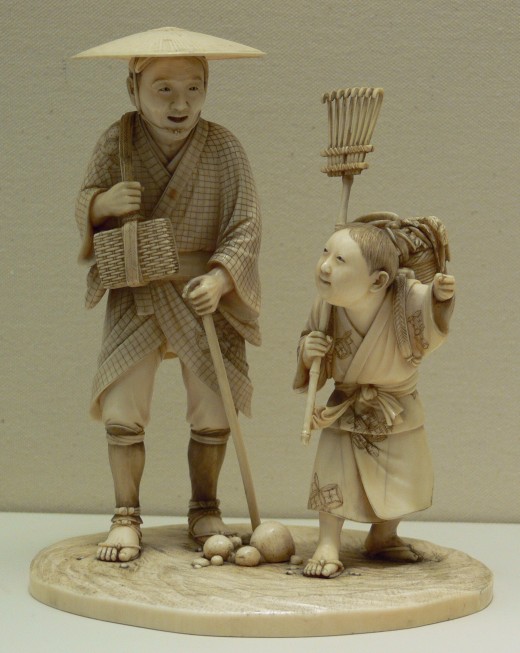
.
‘The illicit trade in ivory, which has been increasing in volume since 2004, moved sharply upward in 2009, according to the latest analysis of seizure data in the Elephant Trade Information System (ETIS).
ETIS, one of the two monitoring systems for elephants under CITES (the Convention on International Trade in Endangered Species of Wild Fauna and Flora) but managed by TRAFFIC, holds the world’s largest collection of elephant product seizure records.
The analysis, undertaken in advance of the 15th meeting of the Conference of the Parties (CoP15) to CITES, was based upon 14,364 elephant product seizure records from 85 countries or territories since 1989, nearly 2,000 more records than the previous analysis, in 2007.
The remarkable surge in 2009 reflects a series of large-scale ivory seizure events that suggest increased involvement of organized crime syndicates in the trade, connecting African source countries with Asian end-use markets. The ETIS data indicate that such syndicates have become stronger and more active over the last decade.
There continues to be a highly significant correlation between large-scale domestic ivory markets in Asia and Africa and poor law enforcement, suggesting that illicit ivory trade flows typically follow a path to destinations where law enforcement is weak and markets function with little regulatory impediment.
Indeed, the rise in illicit trade in ivory indicates that implementation of a CITES “action plan for the control of trade in African elephant ivory,” the Convention’s principal vehicle for closing such unregulated and illicit domestic markets in Africa and Asia, has failed to drive any significant change over the last five years.
The ETIS analysis identifies Nigeria, the Democratic Republic of the Congo and Thailand as the three countries most heavily implicated in the global illicit ivory trade. Illegal trade involving each of these nations has been repeatedly singled out for priority attention since the first assessment in 2002, but they continue to feature as critical hotspots in the trade as sources, entrêpots and consumers of ivory.
Another nine countries and territories—Cameroon, Gabon and Mozambique in Africa and Hong Kong SAR, Malaysia, the Philippines, Singapore, Taiwan and Vietnam in Asia—were also identified as important nodes in the illicit ivory trade.
China, which along with Japan was an approved destination of the legal, CITES-sanctioned one-off ivory sale in 2008, faces a persistent illegal trade challenge from Chinese nationals now based in Africa. Ongoing evidence highlights widespread involvement of overseas Chinese in the illicit procurement of ivory, a problem that needs to be addressed through an aggressive outreach and awareness initiative directed at Chinese communities living abroad.
The results are less clear-cut concerning the impacts of the CITES approved one-off ivory sales in 1999 and 2008.
Following the first such sale, in June 1999, there was a progressive decline in the illicit trade in ivory for five years, with no evidence to suggest that the sale had resulted in an increase in the illicit ivory trade globally.
After the second CITES-approved ivory sale, in late 2008, the results are unclear as to whether it has stimulated increase demand or whether it has simply coincided with an increase in supply that was already underway over the last four years. The collection of more data over an extended time period will throw further light on this vital issue.’
.
The full ETIS report can be downloaded from the CITES website as document at ^http://www.cites.org/common/cop/15/doc/E15-44-01A.pdf
[Read More]
.
.
‘China Fuels East African Elephant Poaching’
[Source: Damian Robin, Epoch Times, 20100330, ^http://www.theepochtimes.com/n2/content/view/32389/, accessed 20110829]
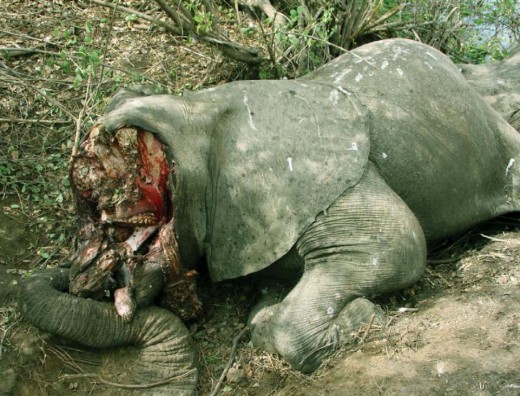
.
China’s influence in East Africa is fueling an upsurge in elephant poaching, gunrunning, and corruption according to a report on U.K. television Friday. A Channel 4 reporter spoke to people in villages and cities, wildlife managers, rangers, government officials, and illegal ivory sellers in Kenya and Tanzania—all of whom said China is the main buyer of banned ivory.
Filmed secretly, sellers told the journalist from Unreported World that during a presidential visit from Chinese Communist Party leader Hu Jintao in 2009, two hundred kilos of ivory was bought by Chinese diplomats and taken out of Tanzania.
The sellers did not say if Hu knew of the trade, but did say that a prominent diplomat from the Chinese Embassy frequently bought large amounts of ivory from them.
Kooky Gorman owns a wildlife park in Kenya. Accompanied by armed rangers, she took the reporter to many spots in her park, where elephant carcasses rotted, their heads split open to make it easy to saw the tusks off.
Many hides showed multiple bullet holes. The lead ranger said the killers had used AK47 automatic weapons to spray herds. The shootings were indiscriminate, killing young and old.
Gorman said the weapons were bought from neighboring Somalia where the civil war has continued since 1991.
The intensity of the poaching has been increasing for the past two years. In 2007 six elephants were poached from her park. In 2008, twenty-eight were poached. Fifty-seven were poached in 2009.
She says there is a threat of elephant extinction.
The Kenya Wildlife Service has strong rooms full of tusks and carved ivory taken during raids and confiscated at Nairobi airport. It has about 65 tons to 70 tons estimated at $10 million.
The U.N. recently rejected Zambia and Tanzania’s request to hold a one-off sale for their ivory stockpile, valued of approximately $15 million.
Since trade in ivory was stopped in 1989, some countries have been allowed to do a small amount of business in ivory if they have good conservation measures. Zambia and Tanzania are currently prohibited from any trade in ivory. The International Trade of Endangered Species of Fauna and Flora (CITES) annual meeting in Doha disregarded arguments that the sale could help police wildlife parks and stop the burden of protecting the horde of ivory.
Selous Game Reserve in Tanzania has 40,000 elephants.
On the TV program, a police informant who lived nearby in a village known for its illegal ivory deals said armed groups of 30 often came from Dara Salam in Senegal to take back ivory in 440-to-660-pound batches. (An average tusk weighs about 4.4 pounds.)
The informant, whose face was not shown for fear of reprisals, had had his house burned down recently.
Another man, who did not want to be identified as he had received death threats, was a safari operator who brings tourists to the Selous Reserve. “I think the wildlife department knows exactly what’s going on here,” he said. “There are some members of the games department who are poaching to supplement their pay and feed their families.”
He said he thinks movers are coming from China and the Far East to take bones and that they are in collusion with local authorities.
He said they could not get through the 15 to 20 policed roadblocks without help from “some very well-placed people.”
One illegal dealer said he had friends in airport security. “It’s no problem with money,” he told the reporter. “If you have money, it’s easy.”
There is a small industry carving the poached ivory for the East Asian trade. “Many people from China come and buy,” he said. There is a market for trinkets, seals, and chopsticks.
Chinese regime officials told Unreported World that they are against the illegal ivory trade and that Chinese diplomats did not illegally purchase or export ivory by misusing diplomatic immunity in 2009.
Most villagers have stood by while violence around the poaching continues. They felt threatened and were unable to prevent the elephant deaths. Now, many see tourism as the main way they can earn a living, so they are protecting the animals and habitat as much as they can.’

.
.
‘Ivory Stockpile Sale Rejected by U.N.’
[Source: Peter Valk, The Epoch Times, 20100324, ^http://www.theepochtimes.com/n2/content/view/31944/, accessed 20110829]
.
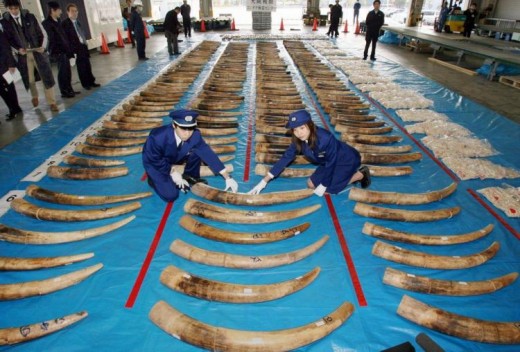 Custom officers display a total of 2.8 tons of ivory on March 1, 2007, a record amount seized in Japan, a top black market destination for elephant tusks.
The U.N.’s Convention on the International Trade of Endangered Species of Fauna and Flora rejected Zambia and Tanzania’s request to sell it’s stockpile of ivory.
(AFP/Getty Images)
. Custom officers display a total of 2.8 tons of ivory on March 1, 2007, a record amount seized in Japan, a top black market destination for elephant tusks.
The U.N.’s Convention on the International Trade of Endangered Species of Fauna and Flora rejected Zambia and Tanzania’s request to sell it’s stockpile of ivory.
(AFP/Getty Images)
.
‘Zambia and Tanzania’s request to hold a one-off sale for their ivory stockpile, valued of approximately $15 million, were rejected during the U.N.’s Convention on the International Trade of Endangered Species of Fauna and Flora (CITES) annual meeting in Doha. The increase of poaching and illegal ivory sales in both countries in 2009 were the main reasons for the rejection.
Since the ivory trade was banned in 1989, there has been an exemption that allows countries that have proven effective in conservation measures to have a small amount of regulated trade in ivory. Currently, Zambia and Tanzania are forbidden to sell ivory.
“It’s crucial that central and western African nations suppress the brazen poaching, mainly fueled by organized crime and illegal ivory markets openly operating within their borders before any further ivory sales take place,” said Sybille Klenzendorf, managing director of Species Conservation at WWF-U.S. in a press release.
According to a report from the Elephant Trade Information System (ETIS), which keeps track of ivory seizures, there exists a direct relationship between an increase in poaching and poor law enforcement. In the past two years, the number of elephants that were killed as a result of poaching has quadrupled.
Opponents of the ban say that Tanzania ought be allowed to dispose of their ivory stockpile as to avoid spending large sums of money on security and storage.
During the meeting, in which 175 countries participated, some animals were added to the list of protected species. The rise of e-commerce is now believed to be one of the latest and biggest threats to wildlife, as global Internet access has made it increasingly easy to buy and sell illegal wildlife products with little control.
“The transactions kind of come and go and take place before anybody really even knows it, leaving it to the post office to be enforcing this global regime of trade regulation,” Paul Todd, a campaign manager for the International Fund for Animal Welfare (FAW) was reported as saying by ABC news in Australia.
Back in 2005, a FAW investigation reported that in one week alone, over 9,000 live animals or products in five categories of animals were for sale on English-language Web sites, chat rooms and the popular auction site eBay. Some of the live animals found included a gorilla in London, and a Siberian tiger in the U.S. Body parts and products were also commonly found with ivory being common.’
.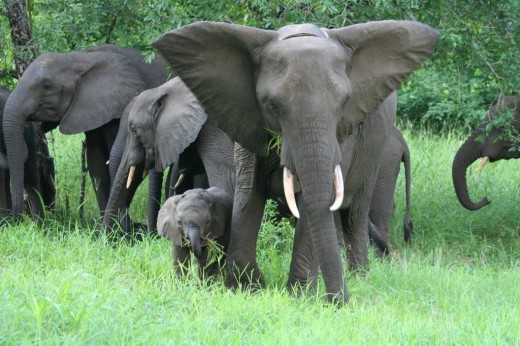
An African Elephant herd
(click photo to enlarge)
Elephants are very intelligent, lifelong loyal and have immense family bonds.
A female elephant listens and watches the photographer intently, with her young close to her side.
An elephant mother will protect her calf to her death.
.
.
 Australia’s big ‘game hunter’, Robert Borsak in Zimbabwe (2008)
Australia’s big ‘game hunter’, Robert Borsak in Zimbabwe (2008)
.

‘Macdonald’s game council thrill killer‘
by Andrew Clennell, State Political Editor, Sydney Morning Herald, 20090721, ^http://www.smh.com.au/environment/conservation/macdonalds-game-council-thrill-killer-20090720-dqui.html]
.
Robert Borsak (on the NSW Government’s Game Council) went to northern Zimbabwe to hunt elephants. On a two-week trip he killed several, including a bull elephant he shot in the head from a distance of six paces.”My reflexes took over as the rifle fired … he went down, as if in slow motion,” writes Mr Borsak in an article entitled Bulls in the Rain posted on the internet. “It was awesome. He did not know what had hit him.”Back in Australia, Mr Borsak has bagged another prize. The big game hunter and former vice-chairman of the Shooters Party is being paid $342 for each sitting day as chairman of the Game Council of NSW, one of 58 quangos which operate under the Primary Industries Minister, Ian Macdonald.
Mr Borsak hopes to run for the Shooters Party at the next election. If successful, he would join a party that now holds the balance of power in the upper house and is holding the Government to ransom after Mr Macdonald failed to negotiate through cabinet the right to shoot in National Parks.It is an example of the kind of interests the embattled Mr Macdonald is accused of helping to protect in some of the committees and statutory bodies he oversees.Mr Borsak is being paid $342 a sitting day for his part in regulating hunting in this state. Conservationists say the Game Council’s only purpose is to win the Shooters Party votes.Last week there were revelations the minister spent close to $150,000 on a wine industry council he set up, chaired by his friend Greg Jones; and that the minister had put other Labor identities – such as union boss Russ Collison and former Labor MPs – on quangos.The Herald learned yesterday Mr Macdonald appointed a friend of 25 years, John Gerathy, the law partner of former Labor deputy prime minister Lionel Bowen, to the wine council and the Homebush motor racing board.
Mr Macdonald is under siege. Yesterday the acting Opposition Leader, Andrew Stoner, referred him to the Independent Commission Against Corruption over claims he gave special treatment to another Labor mate, the former construction union president John Maitland, over granting an exploratory licence for a Hunter Valley mine.
The Premier, Nathan Rees, refused to comment yesterday when asked if the Left assistant secretary Luke Foley, who wants Mr Macdonald’s upper house seat, would be a better cabinet minister than Mr Macdonald.
As for Mr Borsak, he was resentful yesterday that he might be included in a story to do with Mr Macdonald.
The Game Council has received more than $11 million in government funding since 2002 and $3.5 million last year, despite promises from Mr Macdonald it would end up being self-funded.
Mr Borsak said the Game Council was set up in 2002, before Mr Macdonald was minister, and should not be lumped in with other committees as it was a statutory body. He said he was a businessman who received “a grand total of $1368 for last financial year for about 60 days’ work for the council”.
“Why would there be a conflict of interest,” Mr Borsak said, when asked whether his involvement in the Shooters Party might mean he should not be involved in the Game Council. He said of the Zimbabwe hunt: “The fact is I do it [the hunt] and I do it legally and I did it as part of licensed conservation programs. The … tusks belong to the Zimbabwean Government.”
The executive director of the Nature Conservation Council, Cate Faehrmann, said it was time the Game Council’s “activities were thoroughly scrutinised”.
Mr Maddonald’s “aggressive support of the establishment of game reserves and hunting in National Parks is all the more insidious when you realise at least one of the people behind this push likes to kill elephants in his spare time,” she said.
“By pumping millions of dollars into the Game Council, Minister Macdonald is sanctioning bloodsports.”
Mr Stoner called for Mr Macdonald to be sacked. “It seems every day there are more doubts raised about Ian Macdonald … There will be more, so Nathan Rees should do the right thing and sack this minister.”
.
.
‘The cruelty and corruption of the elephant hunt’
[Source: Sydney Morning Herald, following letters to the editor, 20090722, ^http://www.smh.com.au/environment/conservation/the-cruelty-and-corruption-of-the-elephant-hunt-20090722-dtb3.html]
.
Letters to the Editor
‘I began hunting as soon as I was old enough to use a rifle. But the photo of Robert Borsak gloating over the body of an elephant he shot in Zimbabwe fills me with disgust (“Macdonald’s game council thrill killer”, July 21).Zimbabwe is one of few African countries to allow this practice. People typically pay about $US20,000-$26,000 ($25,000-$32,000) for this privilege. Bulls are more expensive, presumably because of their tusks. Where does this money go? Here is a hint.
Advertisement: Story continues belowThe BBC reported a decade ago that the government of Robert Mugabe earned US$2.5 million by selling 20 tonnes of elephant tusks, although the ivory trade had been banned. Zimbabwe lies about its elephant population to get around the ban. This practice is probably greater today.As the economy collapsed, the Zimbabwean Army, the key to Mugabe’s survival, cancelled all contracts to supply beef. The Zimbabwean Conservation Task Force reports soldiers have complained the only meat they are given is from elephants. So in addition to the immense pleasure Borsak apparently feels in the senseless destruction of a great creature, he can also take pride in doing his bit to keep Africa’s worst despot in power.’~ Don Moore, Lilyfield
.
.
‘I loved the juxtaposition of the stories about Robert Borsak, and Sining Wang and Edward Liew (“Don’t have a cow man – it’s got rights”, July 21). Thank heavens for the next generation of intelligent and compassionate thinkers. I hope it is only a matter of time before Wang and Liew can flex their legal muscles against thug shooters such as Borsak. The sooner they are banned from indulging in their cruel and destructive hobbies, the better.’~ Belinda Connolly, Caringbah
.
.
‘It has been said that people get the politicians they deserve.What does it say about the people of NSW when there is a danger of Robert Borsak standing for a seat in Parliament – a man who admits to the thrill of downing a bull elephant “from a distance of six paces”?’Jill Klopfer, Wahroonga
.
.
‘So Robert Borsak killed elephants in Zimbabwe “as part of licensed conservation programs”.The corrupt Zimbabwean Government and conservation are complete strangers, as anyone who has anything to do with trying to save what is left of Zimbabwe’s wildlife can tell you.’Colleen Riga, Potts Point
.
.
‘Robert Borsak says “the tusks belong to the Zimbabwean Government”. No – the tusks belong to the elephant.’Jean-Marc Russ, Darlinghurst
.
.
‘It comes as no surprise to learn of Ian Macdonald’s patronage of hunters. The minister has shown scant regard for the welfare of animals, as those of us working in animal charities can attest. His $3.5 million for the Game Council compares with the $533,000 in funding he announced in April to be split between the RSPCA, Animal Welfare League, WIRES, Cat Protection Society and the Domestic Animal Birth Control Co-operative Society.The Government opposes Clover Moore’s bill to reduce the suffering of cats and dogs by regulating their sale, and even pleas for an inquiry into the welfare of companion animals have been rejected. A minister who gives priority to working with a hunter who describes shooting an elephant as awesome is hardly likely to care that tens of thousands of cats and dogs are killed annually on his watch.’
Kristina Vesk chief executive, Cat Protection Society of NSW, Newtown
.
– end of article –
Tags: African Elephant, Chinese illicit ivory trade, cites, Convention on International Trade in Endangered Species of Wild Fauna and Flora, Environmental Investigation Agency, illegal ivory trade, Ivory trafficking, ivory trinkets, Japanese illicit ivory trade, Robert Mugabe, Selous Game Reserve, Thai illicit ivory trade, TRAFFIC
Posted in Africa, Elephants, Threats from Poaching and Poisoning | 1 Comment »
Add this post to Del.icio.us - Digg
|
|
 Australia’s native kangaroo – targeted by poachers and mass slaughter encouraged by Australian governments
Australia’s native kangaroo – targeted by poachers and mass slaughter encouraged by Australian governments
 .
.













































































